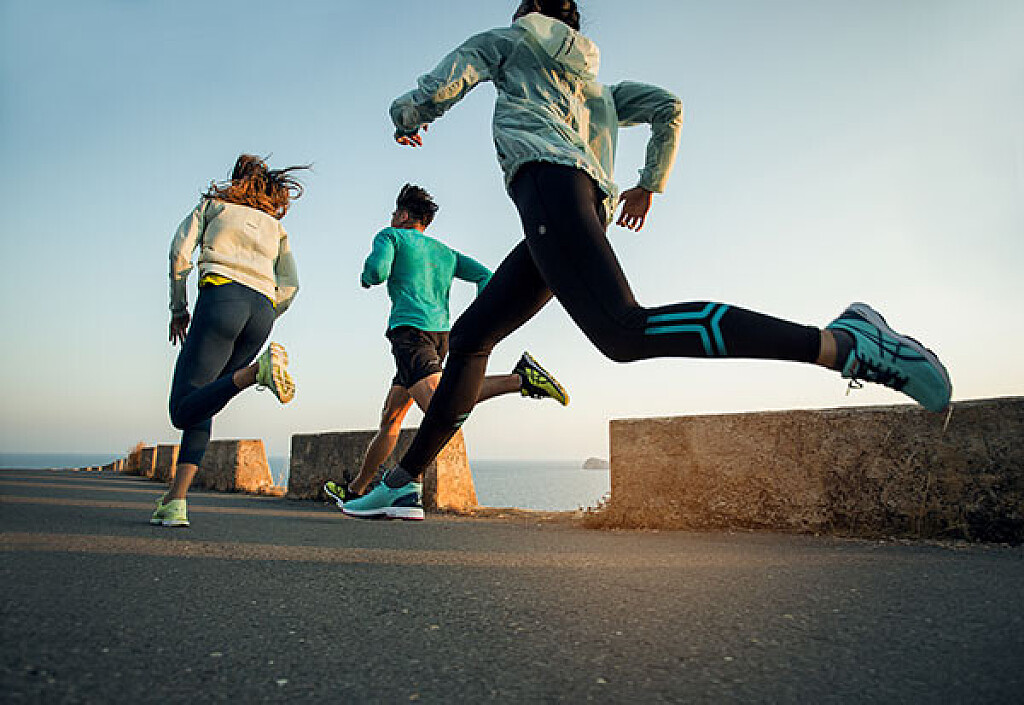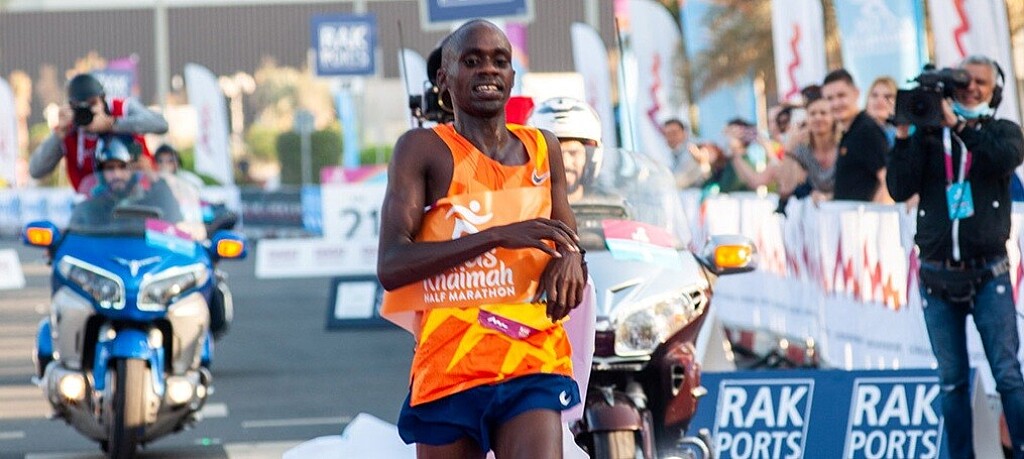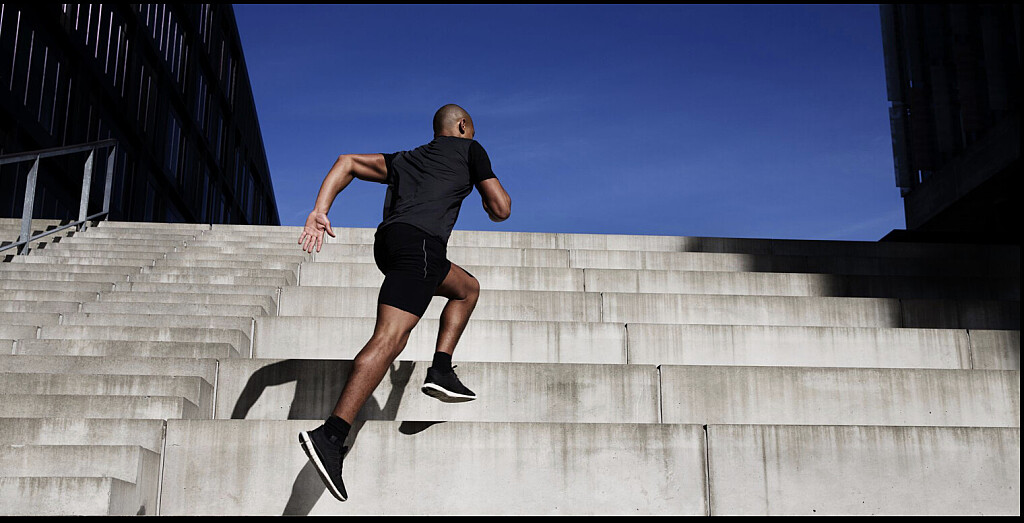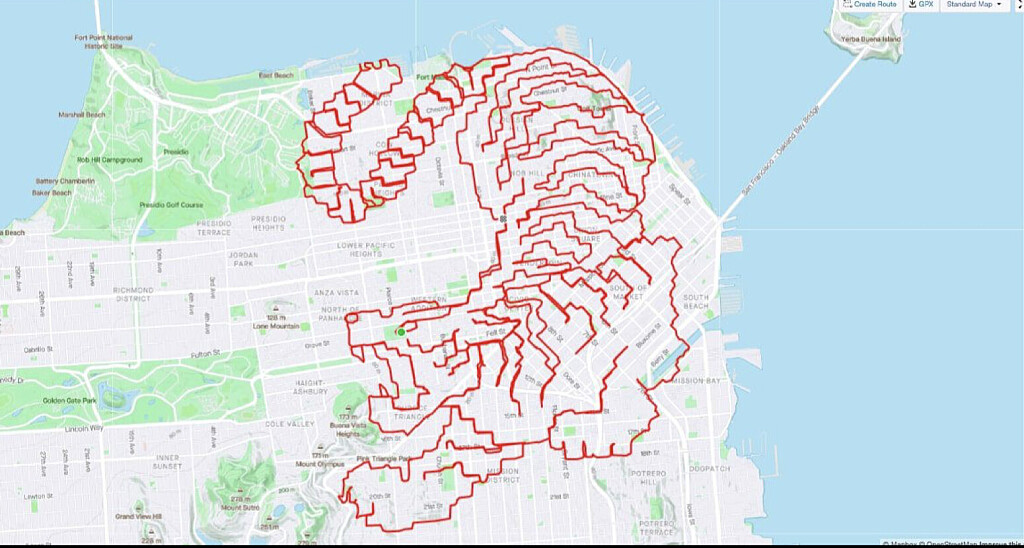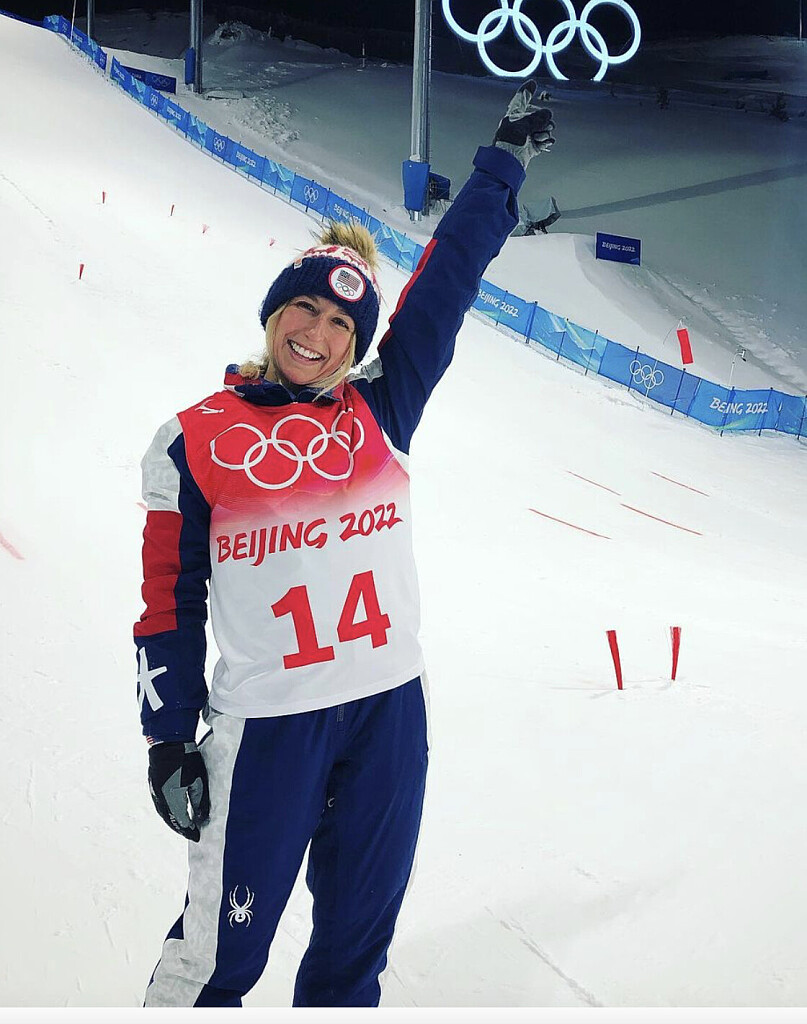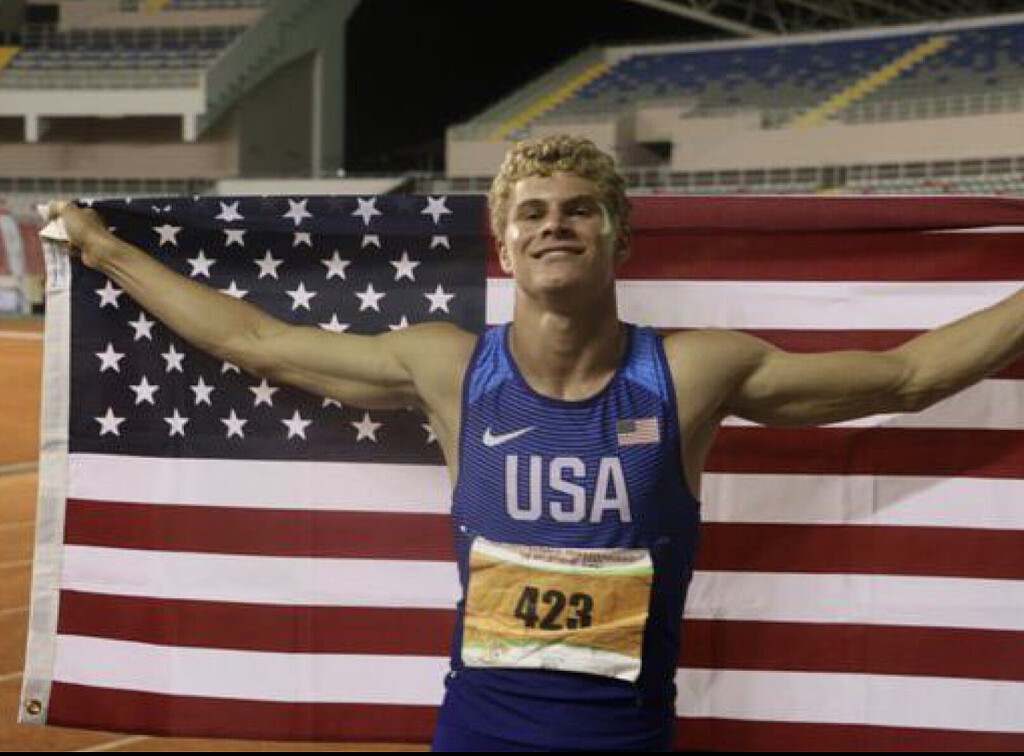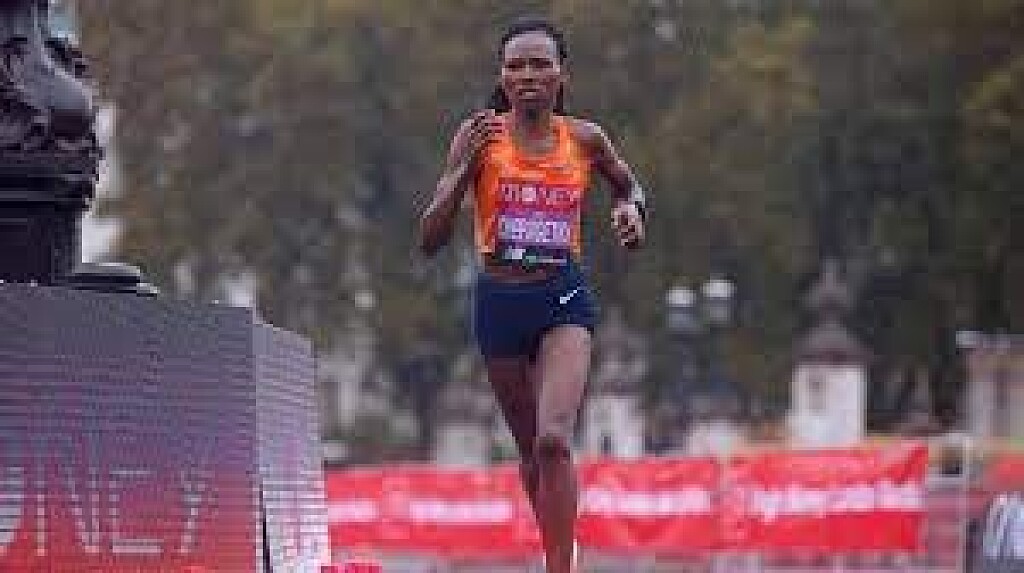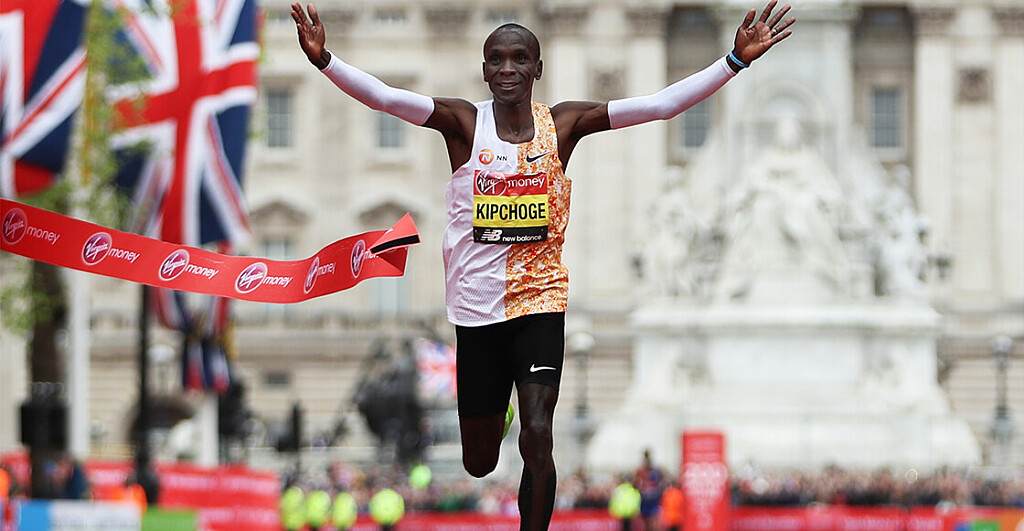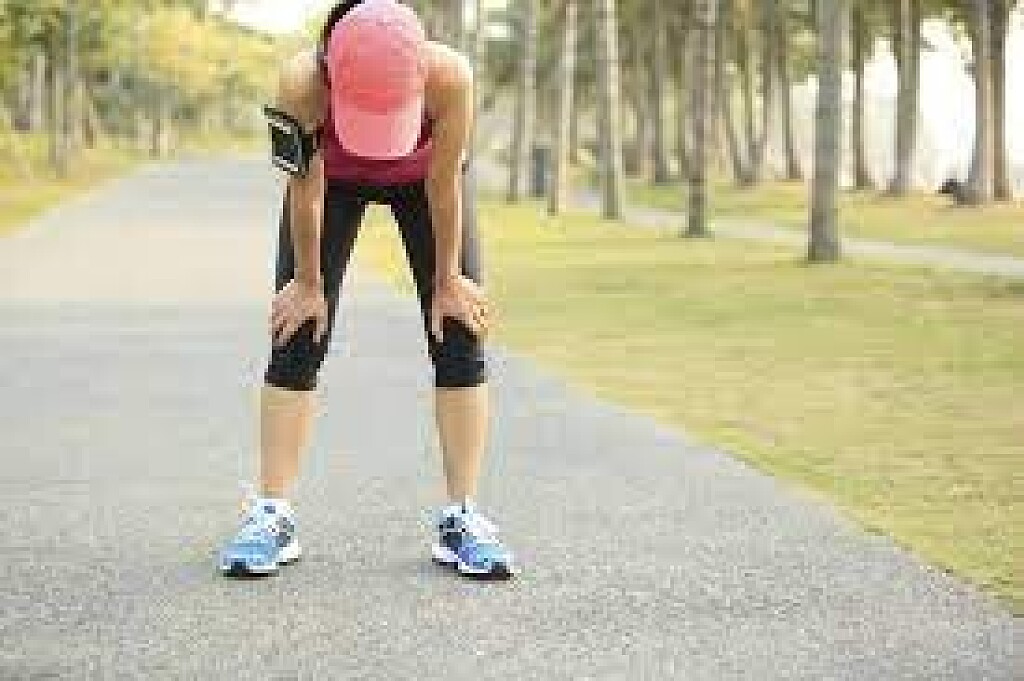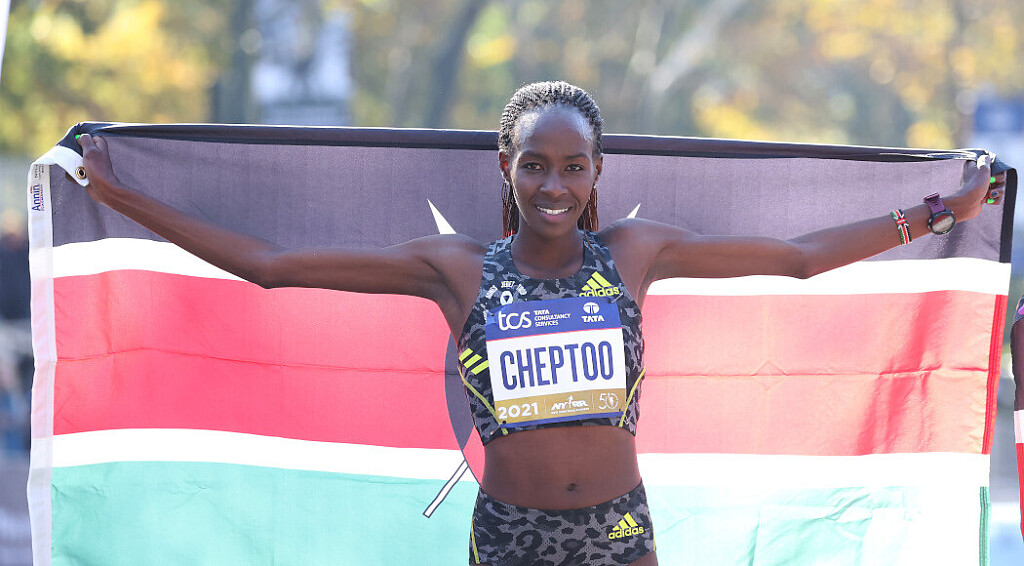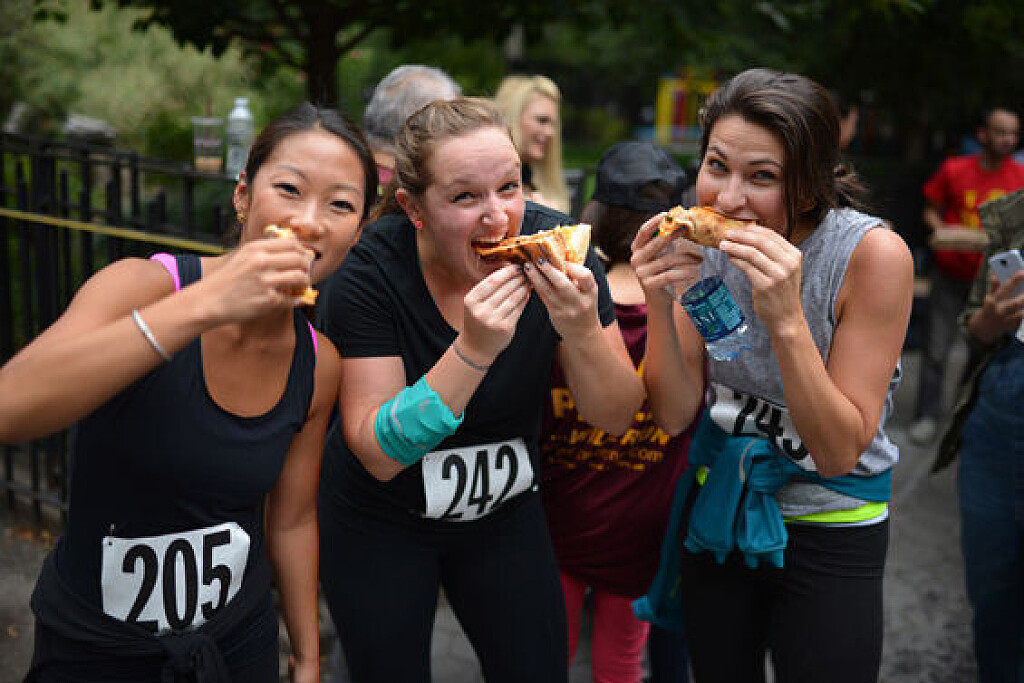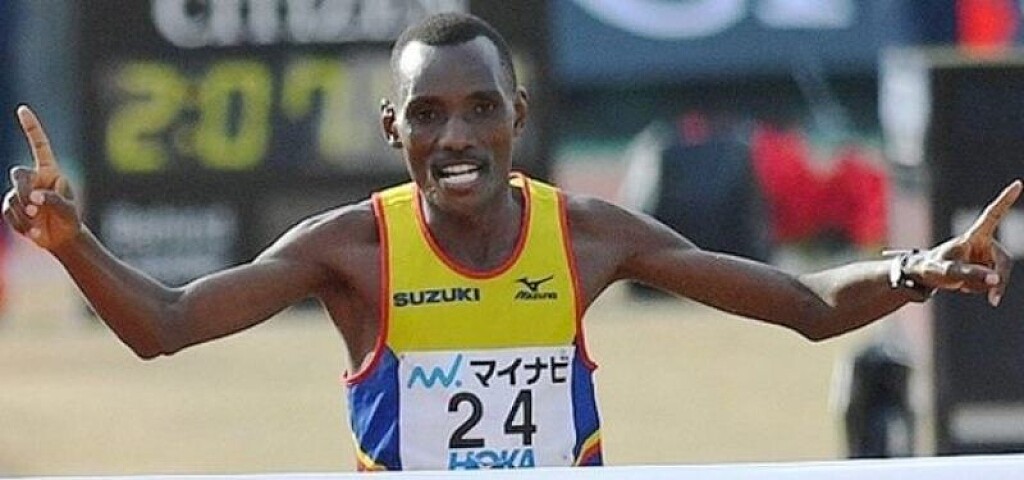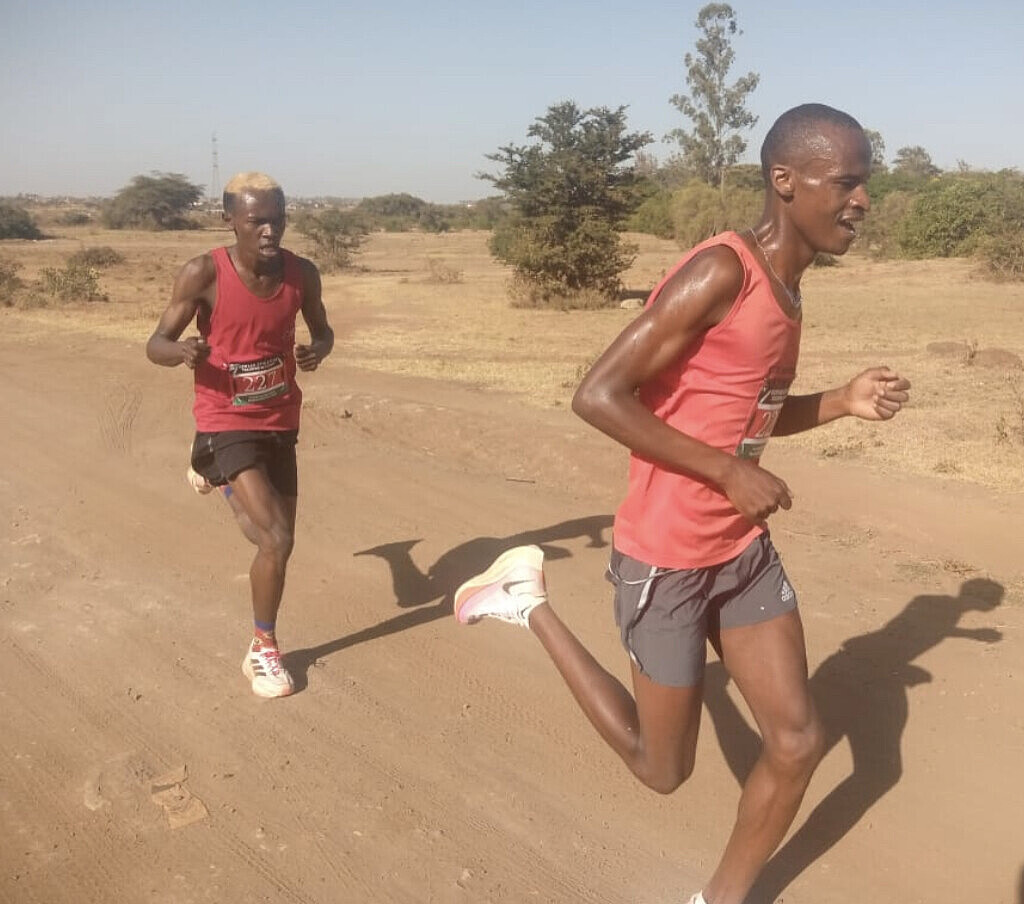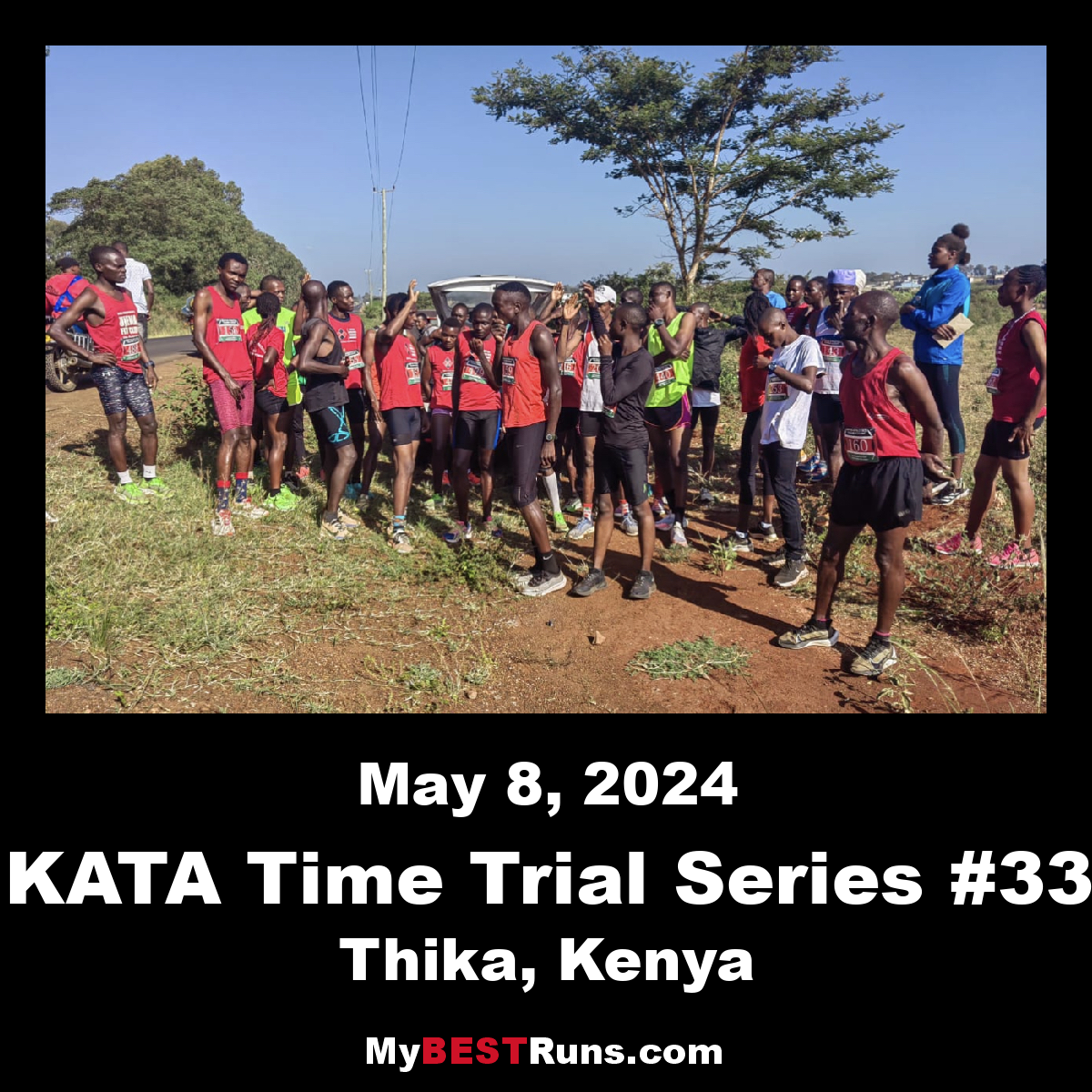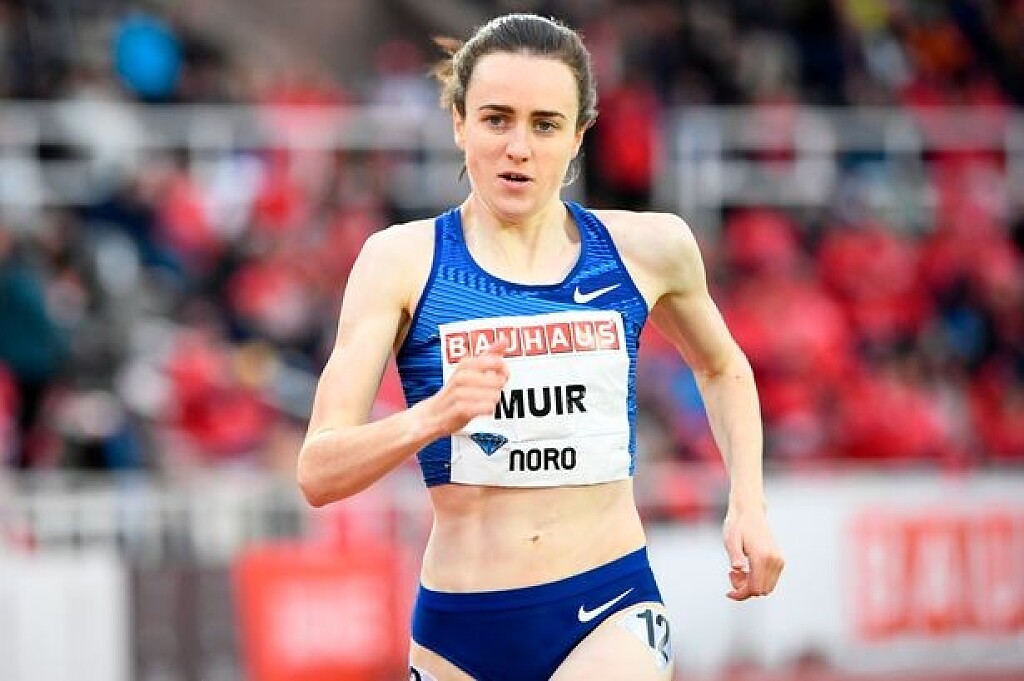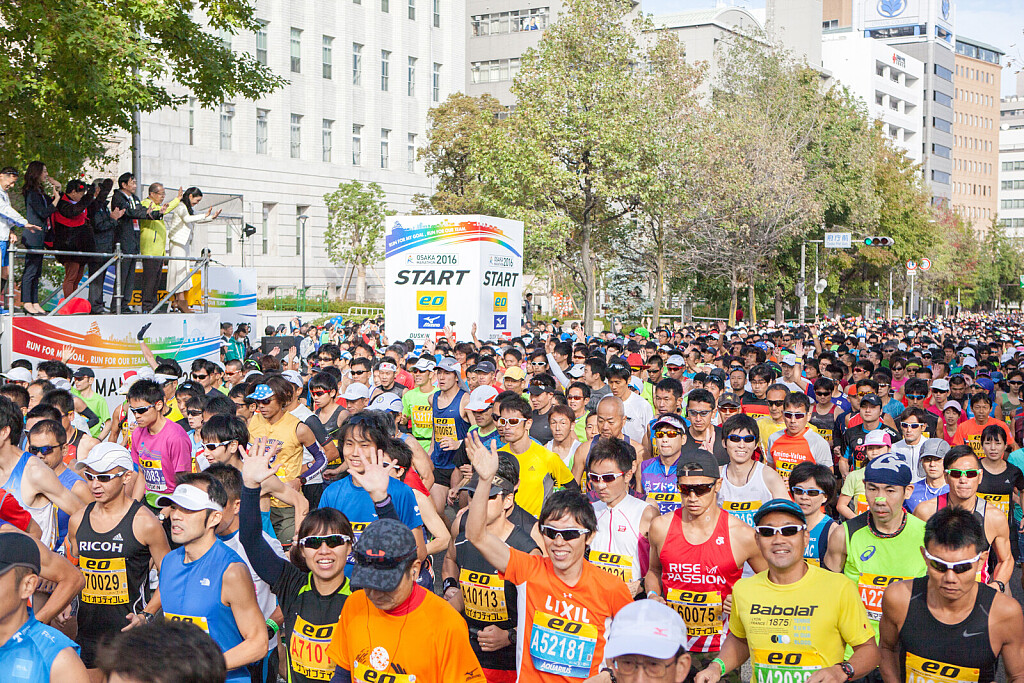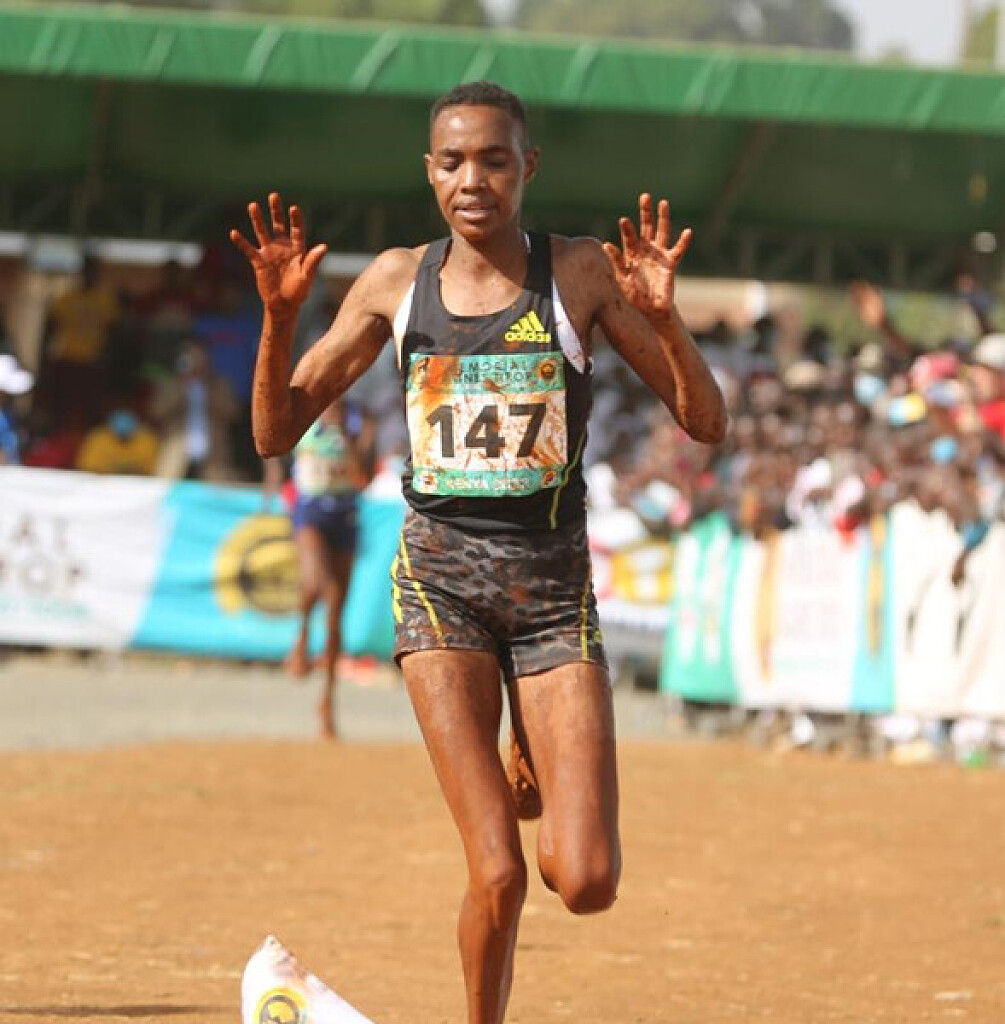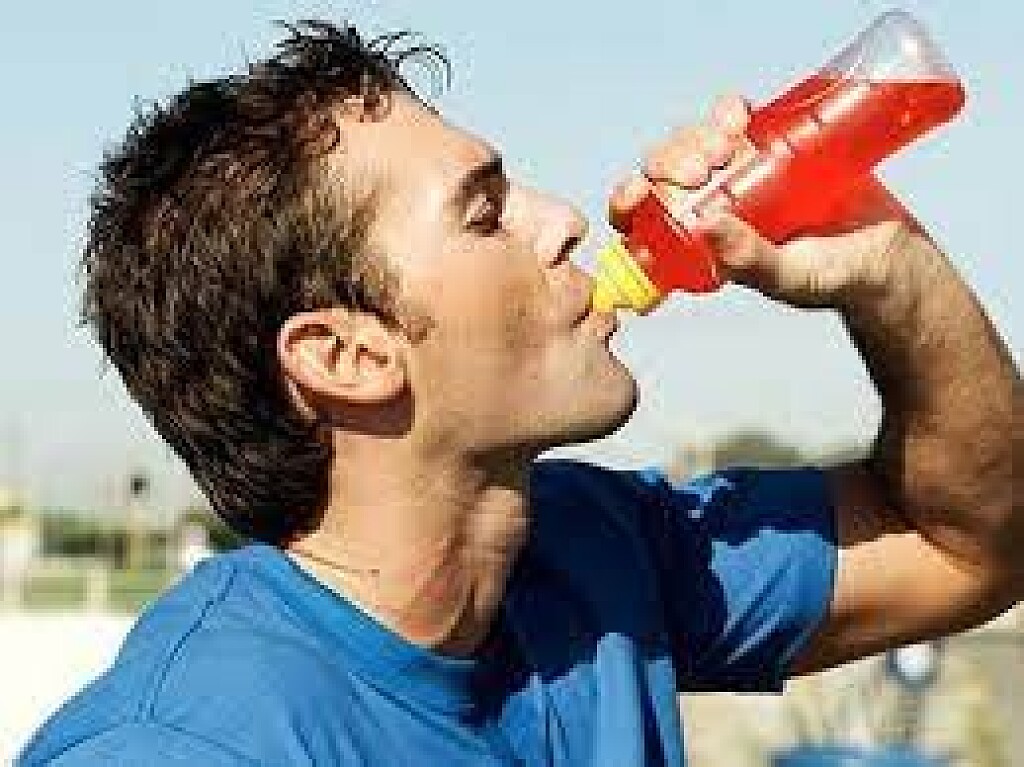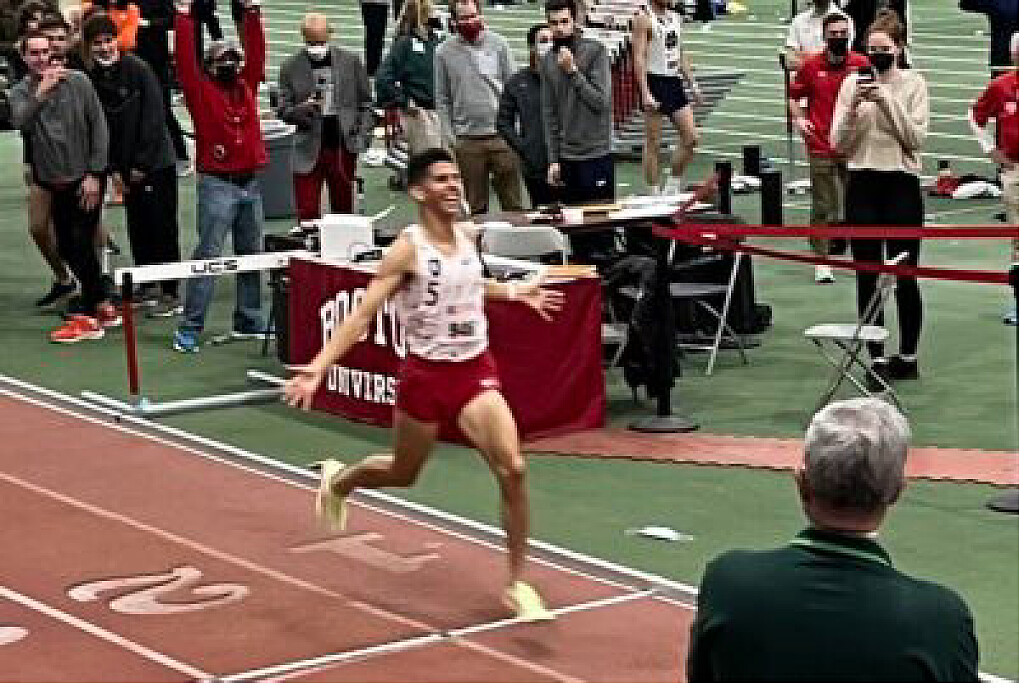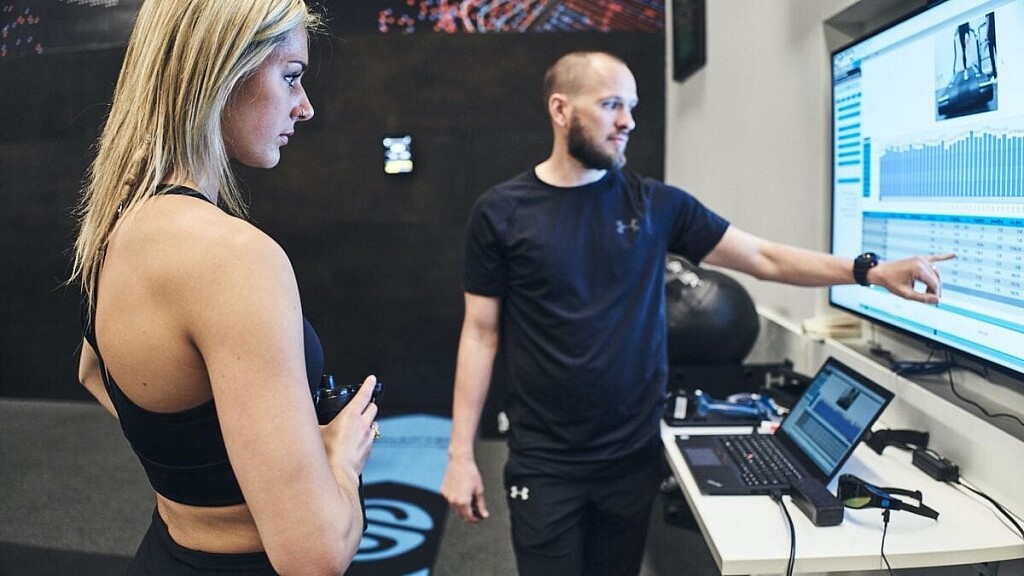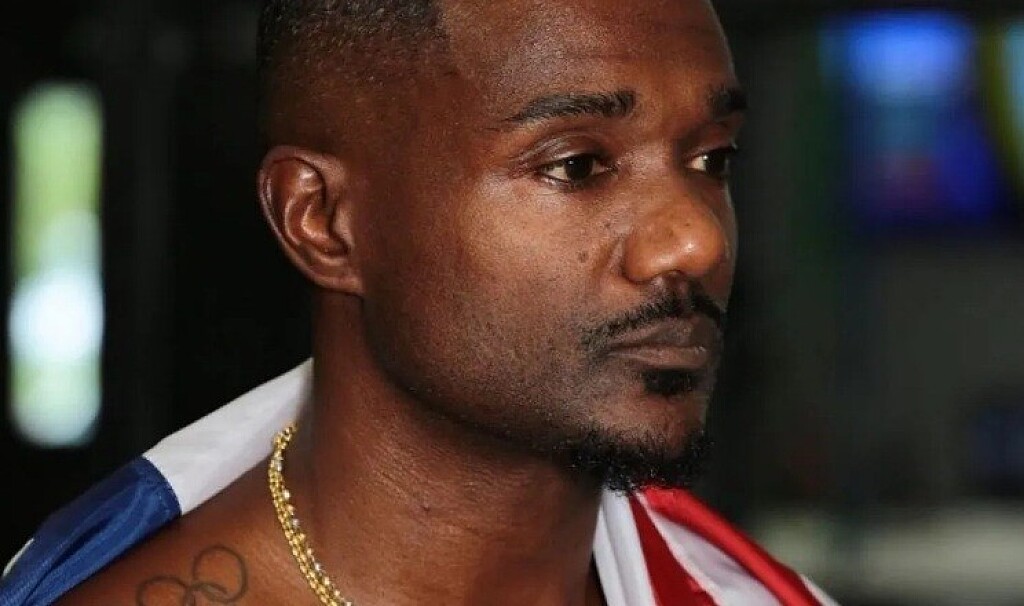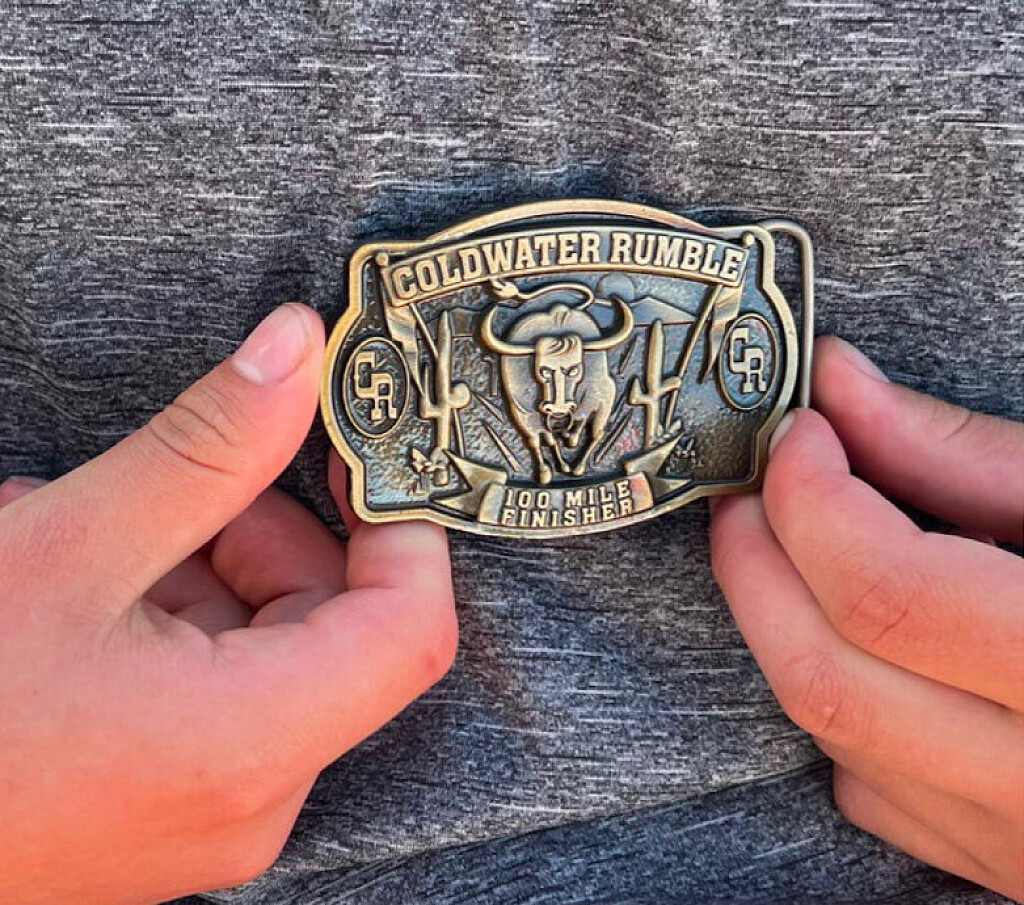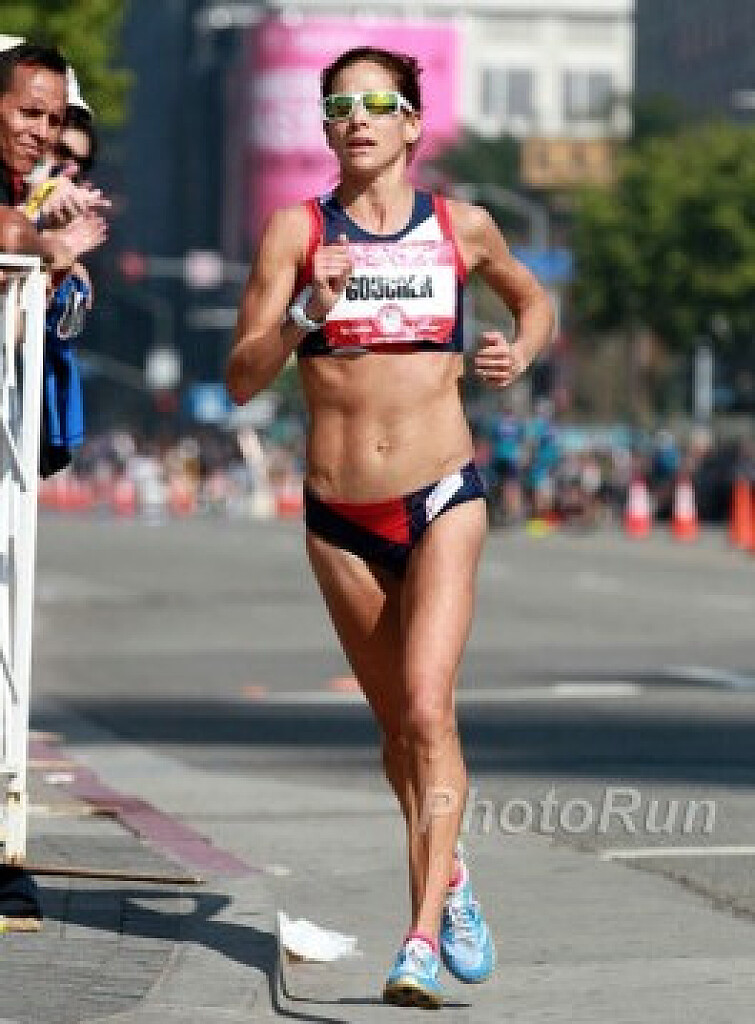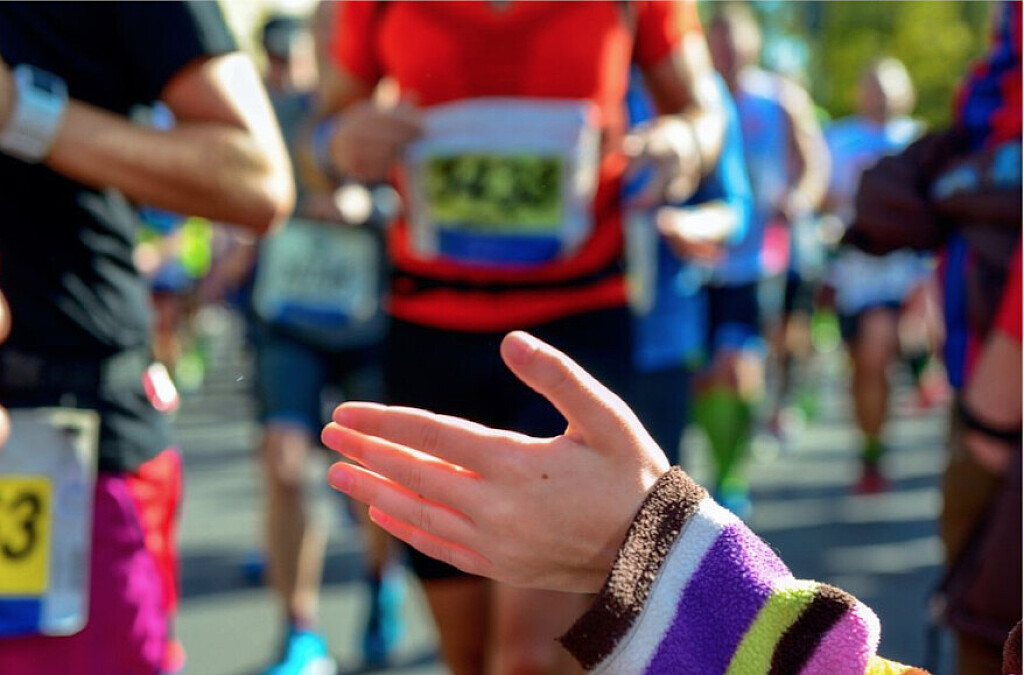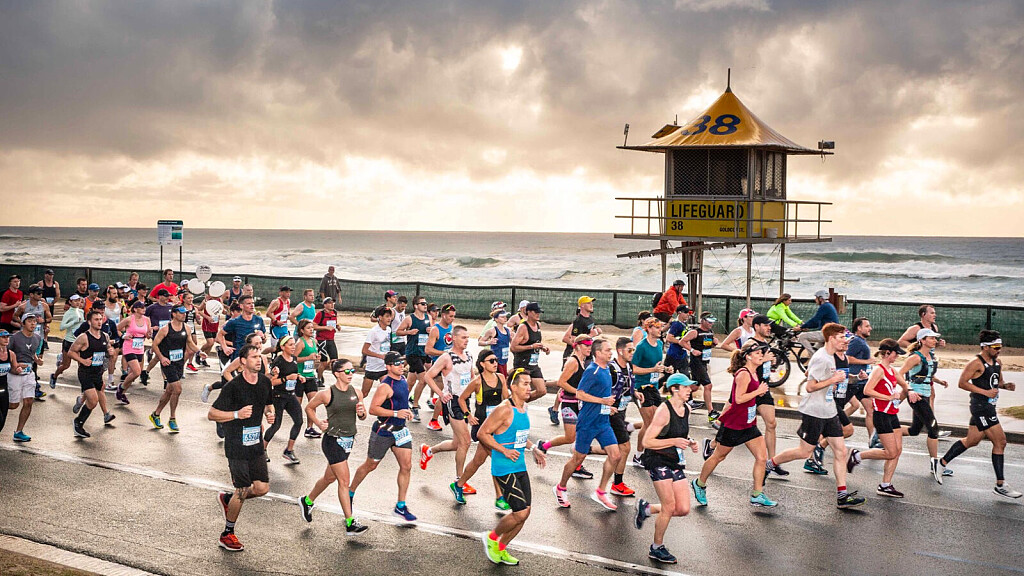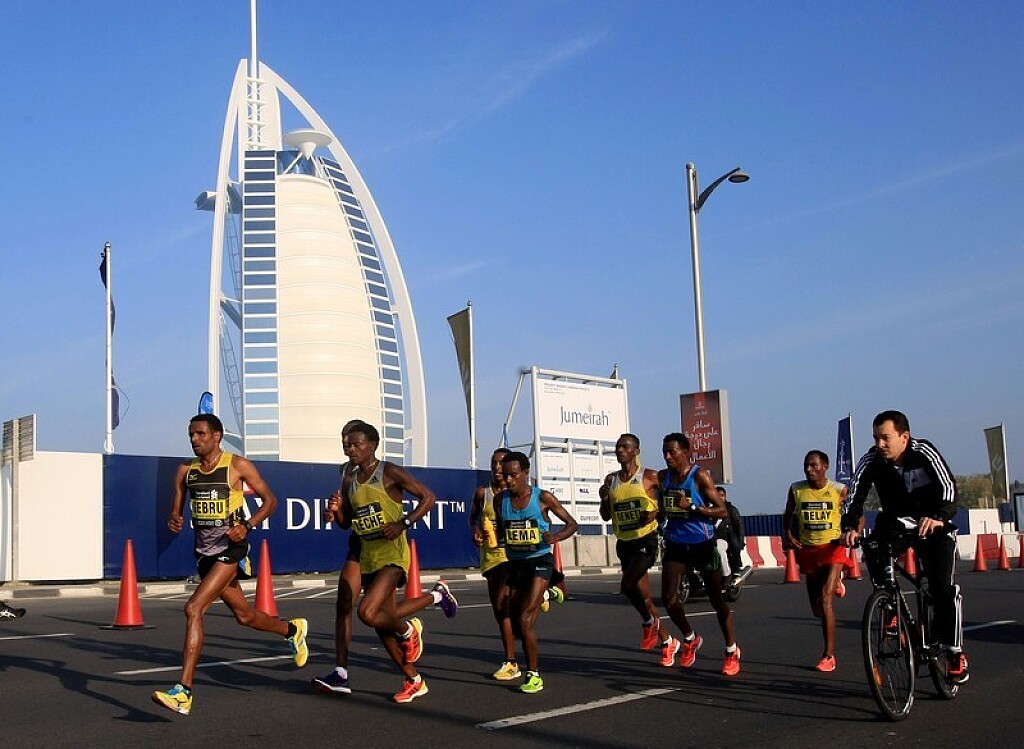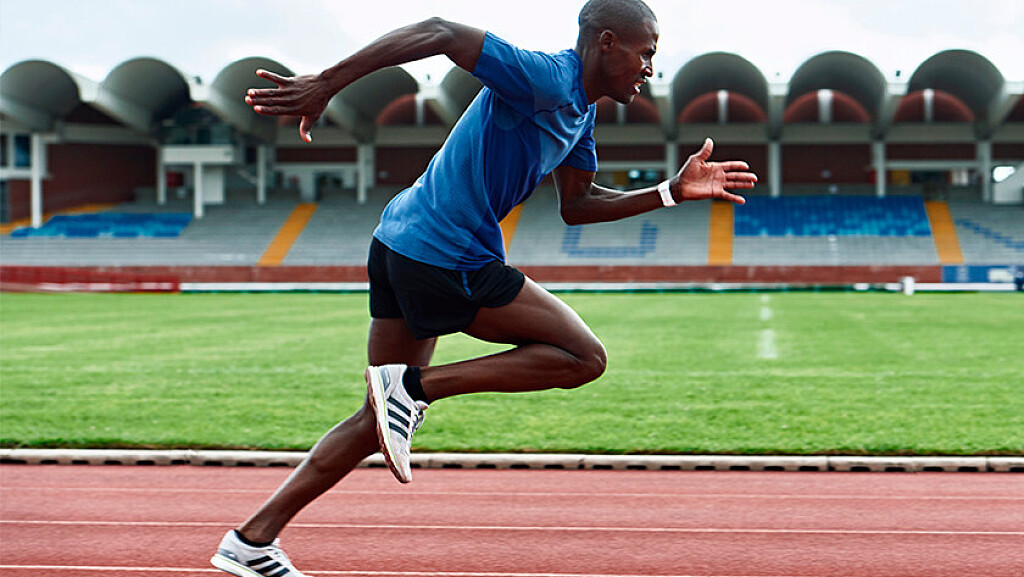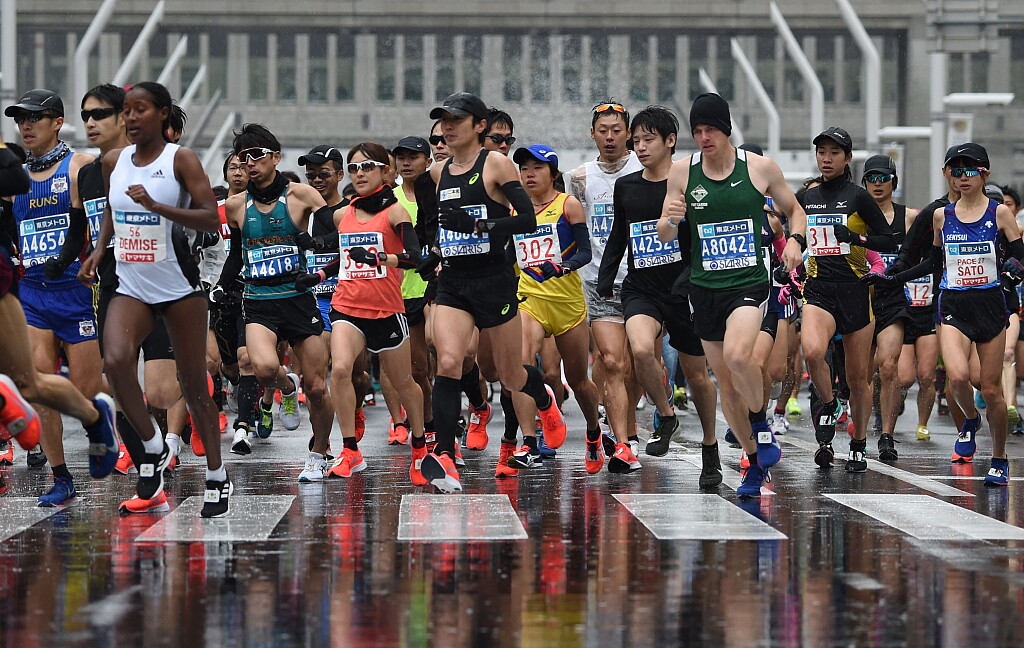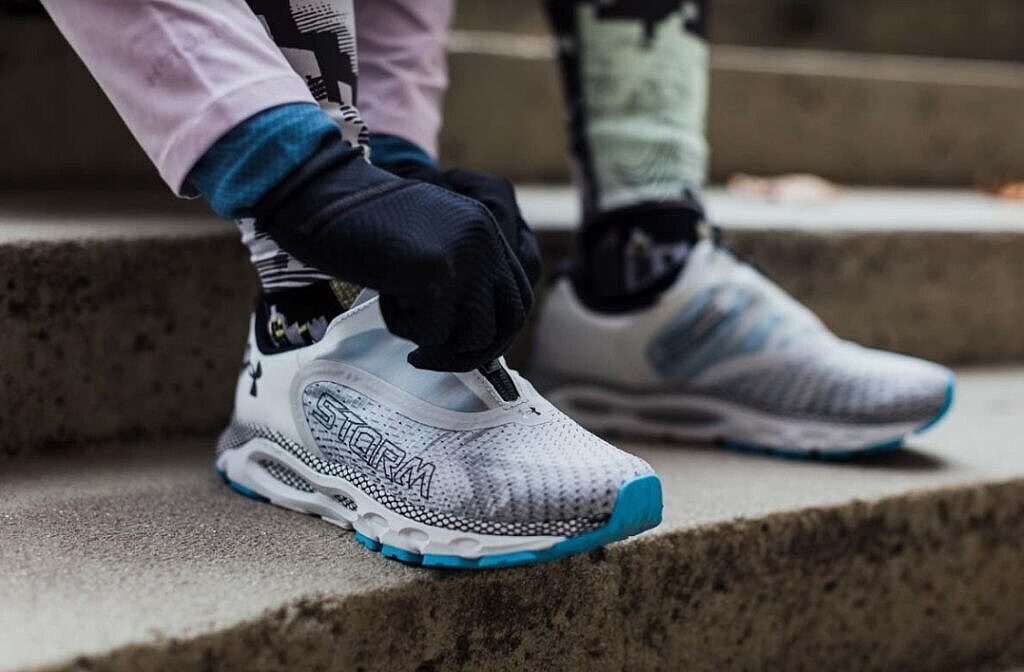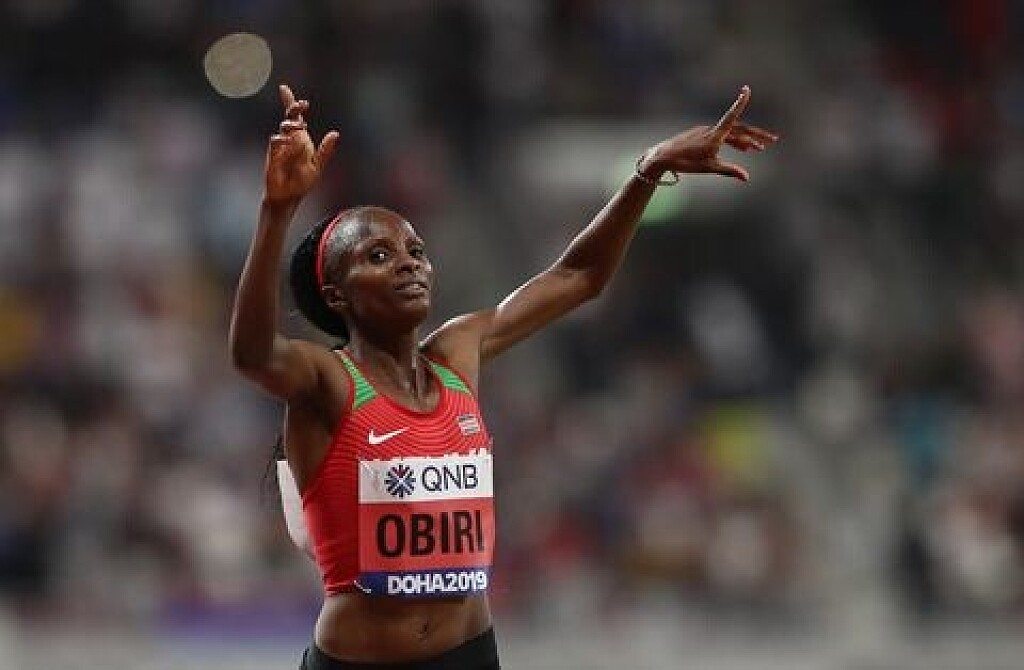Running News Daily
Running News Daily is edited by Bob Anderson in Los Altos California USA and team in Thika Kenya, La Piedad Mexico, Bend Oregon, Chandler Arizona and Monforte da Beira Portugal. Send your news items to bob@mybestruns.com Advertising opportunities available. Train the Kenyan Way at KATA Kenya. (Kenyan Athletics Training Academy) in Thika Kenya. KATA Portugal at Anderson Manor Retreat in central portugal. Learn more about Bob Anderson, MBR publisher and KATA director/owner, take a look at A Long Run the movie covering Bob's 50 race challenge.
Index to Daily Posts · Sign Up For Updates · Run The World Feed
Three steps to building mental strength, what to do before, during and after your run to cultivate mental toughness
Runners understand all too well the importance of mental toughness during a hard workout or race, but just like you train your body for your goal race, you also have to train your mind if you want it to be strong. For many, training your mind can seem not as straightforward as physical training, so if you’re not sure where to start, follow these three steps to fortify your mind before, during and after training.
Before your run
Building mental strength starts before you even start your run. As you’re getting yourself ready to head out the door, start going through the workout in your mind. Remind yourself why you’re doing that particular session, and go over how you’re going to get yourself through the tough parts.

For example, you could say something like this: “I’m doing my long run today to build my endurance so my body will be ready to handle my race distance. When I start to feel tired, I’m going to use my running mantra and motivational self-talk to push myself to keep going.”
Think of this as your “mental workout plan,” and keep running through it in your mind as you put on your shoes and make your way to the door.

During your run
This is when the most challenging mental work happens. During your run, especially when you start to get tired, is when you need to draw upon those strategies that you were thinking about before the run started. As we already mentioned, having a running mantra is a really helpful strategy for developing mental strength during a run or workout. Don’t have one already? Follow these tips to create the perfect running mantra that will keep you going.
After your run
The mental strength training doesn’t stop when your run is over. Before you head inside and carry on with your day, take a minute to go over how your run went in your mind, making note of what you did well during that session. Maybe you weren’t as fast as you had hoped, but you didn’t give up when you saw you were behind. Perhaps that run felt hard, but you managed to push through it and stay mentally tough. If your mental game slipped during that run, make a note of what went wrong so you can work on it next time.
Intentional mental work
The key here is that you have to be intentional about working on your mental toughness. Many runners believe that their mental strength will improve passively alongside their physical strength as they train, but this is often not the case. Too often, runners’ mental strength lags behind their physical abilities, holding them back from realizing their full potential. Make a point of working on at least one aspect of your mental game every time you step out the door, and your performance will improve right along with it.
(02/19/2022) ⚡AMPby Brittany Hambleton
Jacob Kiplimo and Girmawit Gebrzihair break course records in Ras Al Khaimah
Uganda’s Jacob Kiplimo and Ethiopia’s Girmawit Gebrzihair ran course records to win the Ras Al Khaimah Half Marathon on Saturday (19), clocking 57:56 and 1:04:14 respectively during another fast edition of the World Athletics Elite Label road race.
Kiplimo had gone into the race targeting his own world record of 57:31, which he set in Lisbon in November. The 21-year-old world half marathon champion, who finished third in the 10,000m and fifth in the 5000m at the Tokyo Olympics last year, was on blistering pace for much of the race, recording a split of 13:23 for 5km and then going through 10km in 26:56 – on target for a sub-57:00 half marathon. By that point he was 16 seconds ahead of Kenya’s Rodgers Kwemoi, with a group including Kenneth Kiprop Renju, Alexander Mutiso, Daniel Kibet, Amedework Walelegn, Abel Kipchumba, Seifu Tura and Kennedy Kimutai another six seconds back.

Kiplimo’s pace dropped slightly over the next 5km but he still passed 15km in 40:43, a time which beats the world 15km best of 41:05 which had been set by his compatriot Joshua Cheptegei in Nijmegen in 2018. Although the world half marathon record seemed to be moving out of reach, Kiplimo went through the 20km mark in 54:53, 33 seconds ahead of Kwemoi, before crossing the finish line in 57:56 to win by 34 seconds.
The fifth-fastest half marathon in history, it is the third occasion that Kiplimo has broken 58 minutes for the distance, a time that only three other athletes – Kenya’s Kibiwott Kandie, Rhonex Kipruto and Mutiso – have ever achieved.

The top six athletes all beat the previous course record of 58:42, which had been set by Bedan Karoki in 2018 and then matched by Stephen Kiprop in 2019. Kenya’s world 10,000m fourth-place finisher Kwemoi was second in 58:30, which moves him to 11th on the world all-time list, while his compatriot Renju was third in 58:35.
Ethiopia’s Tura was one second back in fourth, with his compatriot Walelegn fifth in 58:40 and Kenya’s Kibet sixth in 58:45. Mutiso and Kipchumba also dipped under 60 minutes, running 58:48 and 59:47 respectively.
Gebrzihair wins on debut
Gebrzihair made a successful start to her half marathon career in the women's race, her course record of 1:04:14 being the second-fastest ever women’s debut for the distance behind Letesenbet Gidey’s world record of 1:02:52 run in Valencia in October.
The 20-year-old Gebrzihair, who claimed world U20 5000m bronze in 2018 and recently finished second in the Great Ethiopian Run 10km, was joined by athletes including Kenya’s two-time world 5000m champion Hellen Obiri and Sheila Chepkirui as well as Ethiopia’s Bosena Mulate in an eight-strong group which went through 5km in 15:12. That pack was down to five athletes by the 10km point, which Gebrzihair, Obiri, Mulate, Chepkirui and Kenya’s Judith Jeptum passed in 30:28.
Obiri, Gebrzihair and Chepkirui then broke away and went through 15km together in 45:50, before Chepkirui was dropped and the leaders clocked 1:01:04 through 20km. Gebrzihair kicked over the closing stages to secure success on her debut, eventually winning by eight seconds in 1:04:14 to Obiri’s 1:04:22. Chepkirui was third in 1:04:36 and the top three in Ras Al Khaimah now respectively sit fourth, fifth and seventh on the world all-time list.
Jeptum finished fourth in 1:05:28 and Mulate fifth in 1:05:46. In sixth, Britain’s Eilish McColgan ran 1:06:26 to break Paula Radcliffe's national record of 1:06:47, which had stood since 2001.
Kenya’s Daisy Cherotich, Bahrain’s Eunice Chebichii Chumba and Kenya's Pauline Esikon were all also under 68 minutes, with respective times of 1:06:33, 1:07:22 and 1:07:50. Yeshaneh was also in action but after passing 15km in 46:08, the former world record-holder did not finish the race.
The performance improves on the 1:04:31 course record – then a world record – set by Ababel Yeshaneh the last time the Ras Al Khaimah Half Marathon was held in 2020.
(02/19/2022) ⚡AMPby World Athletics
Rak Half Marathon
The Ras Al Khaimah Half Marathon is the 'world's fastest half marathon' because if you take the top 10 fastest times recorded in RAK for men (and the same for women) and find the average (for each) and then do the same with the top ten fastest recorded times across all races (you can reference the IAAF for this), the...
more...Struggling With Dry, Itchy Eyes? Go for a Run
Even a single exercise session can help your eye health, according to new research.
If you’re struggling with dry, itchy, burning eyes, aerobic exercise can help, new research shows.

Exercise plays a role in better blood circulation and reduced inflammation, both of which affects eye health.
Maybe you stare at small, glowing screens just a little too much every day, or you’re not as hydrated as you could be, or you’re dealing with issues like hormone changes, aging, low humidity, or allergies. No matter what the cause, you might be struggling with dry, itchy, burning eyes. But there could be an easy fix, according to a new study in the journal Experimental Eye Research. Go for a run.
Researchers split 52 participants into two groups: One did exercise sessions on a treadmill five times per week while the other did a single weekly treadmill run. Eye exams were done right before and right after each session, with a focus on changes in what’s called “tear film.”
Quick anatomy refresher: Tear film is produced when we blink, and hydrates the surface of the eye in a thin layer that protects against irritants like dust. When tear film production is reduced, that creates dry spots where those particles can land on the eye’s surface and cause dryness and itching.
In the recent study, those doing more exercise saw greater consistency in their tear film production, but even participants running only once a week got a boost, according study to co-author Heinz Otchere, Ph.D.(c), a researcher in vision science at the University of Waterloo in Canada.
“This indicates that a single session of exercise can have benefits for your eyes,” he told Runner’s World. “That means if you’re experiencing eye dryness, from an activity like too much screen usage, aerobic exercise can be a great strategy to address it rather than relying on eye drops all the time.”
The effect of exercise is tied to how activity plays a role in better blood circulation, said Otchere, which affects your eyes as much as the rest of your body. He added that exercise has also been linked to lower inflammation in general, which offers another boost to eye heath.
Added to that, previous research indicates exercise has shown to improve what’s called intraocular pressure, which is the measure of how fluid pressure is maintained between the back part and the front part of your eye. Because of that, a 2018 study in the journal Eye suggests exercise can help prevent several eye conditions like glaucoma, age-related macular degeneration, and diabetic retinopathy, which are all associated with lower activity levels.
“The takeaway from our research and previous studies is that exercise can lead to significant improvement in eye health, and the more activity you get, the greater that improvement becomes,” said Otchere.
(02/19/2022) ⚡AMPby Runner’s World
Not Surprisingly, Alcohol Isn't Doing You Any Favors When It Comes to Building Muscle
Too much booze is bad news, research shows.
There probably aren’t many people out there who imagine that drinking a case of beer will make you a better athlete. Still, there are lots of people who argue that it doesn’t really matter either way—that training is training and social life is social life, and the two don’t really affect each other.

The basic idea of the study was straightforward:
Put volunteers through a rigorous exercise routine (it was a mix of weights, sustained cycling, and high-intensity sprints, designed to simulate the demands of a team-sport match); have them do it three times. After two of the trials, give them the “optimal” post-exercise nutrition: 25 grams of protein immediately after, a carbohydrate-rich meal two hours later, and another 25 grams of protein four hours later. During this recovery period, have them drink a bunch of drinks, either containing placebo or a total of 1.5 grams of alcohol per kilogram of body weight. In a third trial, give them alcohol, but replace the protein with calorie-equivalent carbohydrate.
What makes this study so good is that the scientists looked right into the muscles to observe what was happening in response. That means each of the three trials involved three muscle biopsies and 17 blood samples—not for the faint of heart!
There are a lot of outcomes, but the bottom line is muscle protein synthesis: how much muscle is being built to repair damage from the exercise and build bigger/stronger new muscle?
Here’s what the synthesis rates look like:
Not surprisingly, the pre-exercise (rest) value is the lowest, and the optimal (post-exercise, no booze) value is the highest. In between, you’ve got the two alcohol trials.
Alcohol plus protein is better than alcohol plus carb, but not as good as protein alone. Note that this has nothing to do with how much rest you’re getting, how hungover you are, or any of that other business. This is simply showing that if you exercise and then drink 1.5 g/kg of alcohol, the signals that would normally tell your body to adapt and get stronger are suppressed immediately.
The results don’t come as a big surprise. For example, scientists at Massey University in New Zealand published a series of studies showing that recovery from delayed-onset muscle soreness is hampered by alcohol.
The big question, of course, is dose. How much is 1.5 grams per kilogram, anyway? Well, in the U.S., a “standard drink” is considered to be 14 grams of alcohol. So for someone who weighs 150 pounds, 1.5 g/kg is 102 grams in total, which translates to 7.3 standard drinks—a fairly big evening for most people. In the New Zealand study, 1.0 g/kg (4.9 drinks for the 150-pound person) hindered recovery, but 0.5 g/kg (2.4 drinks) didn’t.
Again, this should score pretty low on the surprise-o-meter. If you’re downing seven drinks in an evening, you’re presumably prioritizing something other than optimal muscle protein synthesis—and that’s fine, as long as you understand this and are making an informed decision. Just don’t kid yourself.
(02/19/2022) ⚡AMPby Runner’s World
Strava runner creates incredible drawing to celebrate Lunar New Year
In celebration of the Lunar New Year, the Picasso of Strava, Lenny Maughan, sketched out a tiger by running the streets of his hometown, San Francisco, and it is easily the most intricate piece of Strava art we’ve yet seen.
According to Maughan’s Strava data, it took him 21 and a half hours over four days to draw this 153-kilometre masterpiece, with over 2,690m of elevation gain in one of North America’s hilliest cities. (This run is sensational, even without the detailed Strava art.)


Maughan has sketched many previous doodles, such as a shamrock for St. Patrick’s Day, a pig, a footprint and the artist Frida Kahlo. According to his Strava, he tries to run six to eight drawings a year in the north end of San Francisco.
In a 2019 interview with SFGate, Maughan described the planning that goes into each piece. He prints out a paper map and sketches his route. He usually goes through several different iterations of the map before he sets off on a run. While he’s on his run, he must be very careful to follow the route – if he makes a wrong turn it could ruin the whole piece.
Maughan has established a large following for his GPS art on his Strava page. You can check out more of his sketches here.
(02/19/2022) ⚡AMP
by Running Magazine
Beijing Olympic skier holds record for youngest person to run a marathon on every continent
Most sports fans will recognize Winter Vinecki for representing the United States in the aerials skiing competition in Beijing, but long before she made her Olympic debut, she was a runner. Vinecki began running races when she was just five years old, and as a teenager, she became the youngest person to run a marathon on every continent.
According to usskiandsnowboard.org, Vinecki ran her first 5K when she was five, her first 10K when she was eight and her first 10-miler (16K) when she was only 10. The now-23-year-old from Michigan also competed in triathlons as a kid and has several medals to prove it.

Showing obvious athletic ability from a young age, Vinecki’s purpose behind her athletic pursuits took on a new meaning when she was only nine and her father was diagnosed with an aggressive form of prostate cancer. From that moment, she began competing (often alongside her mother, Dawn Estelle) to raise awareness about the disease. Sadly, her father passed away less than a year after his diagnosis. A year after losing her father in 2010, Vinecki won her first IronKids National Triathlon, which she would go on to win for the second time in 2011.
Shortly after her second win, she found out the record for the youngest person to complete a marathon on all seven continents was held by a 27-year-old man, and decided she could easily beat that. Her mother agreed, and at 13, Vinecki got to work. Starting with the Eugene Marathon in Oregon, the Amazing Maasai Marathon in Kenya and the Antarctica Marathon, by the age of 14 she had already checked the first three off her list. Her fourth marathon was the Inca Trail Marathon, considered the toughest marathon in the world, thanks to its steep mountain passes, which the teen ended up winning in nine hours and 18 minutes.
She went on to complete a marathon in Mongolia, New Zealand and finally Athens to complete her trip around the globe. The 14-year-old, who had already qualified for the Junior Freestyle Skiing World Championships but given up her spot to complete her marathon challenge, then returned to the slopes with her eyes on qualifying for the 2018 Winter Olympics in Pyeongchang. An ACL tear prevented her from competing that year, so her Olympic debut was put off until 2022 in Beijing.
In her first Olympics, Vinecki ended up finishing 13th in her qualifying round and did not make it into the final, but with so much grit and determination, we will no doubt see her on the slopes again.
(02/19/2022) ⚡AMPby Running Magazine
Matthew Boling snags Dunkin' Donuts' first track sponsorship
TThe popular U.S. doughnut chain Dunkin’ Donuts has signed Georgia sprinter Matthew Boling, as the captain of Team Dunkin’, marking the brand’s first connection to an NCAA athlete.he po
“America runs on Dunkin’,” and now so does Boling, a four-time 2019 U20 Pan-Am Games gold medallist, who is currently competing for the University of Georgia in Athens, Ga.


Boling went viral in 2019 when he broke the 10-second barrier for 100m with a wind-aided 9.97 seconds. pular U.S. doughnut chain DunkiMost athletes would only dream of what comes with a coffee and doughnut sponsorship. U.S. 1,500m Olympian Heather MacLean was disgruntled by Dunkin’s decision not to choose her, expressing her displeasure on Twitter.n’ Donuts has signed Georgia sprinter Matthew Boling, as the captain of Team Dunkin’, marking the brand’s first connection to an NCAA athlete.The popular U.S. doughnut chain Dunkin’
She even already has the tracksuit.
Dunkin’ Donuts is headquartered in Canton, Mass. It was founded in 1950Although MacLean is no longer in college, her Dunkin’ tracksuit has hopefully made a strong case for a potential sponsorship in the future. U.S. marathoner Molly Seidel also has a soft spot for Dunkin’. While she was living and training in Boston, Dunkin’ became her donut shop of choice, and she also spoke about her interest in a Dunkin’ sponsorship.Boling will be representing Dunkin’ on and off the track, sharing his exclusive Team Dunkin’ experience and merchandise on social media. Each Team Dunkin’ athlete will be honoured by having their very own Dunkin’ drinks and food featured at a Dunkin’ location in their college town.Donuts has signed Georgia sprinter Matthew Boling, as the captain of Team Dunkin’, marking the brand’s first connection to an NCAA athlete.
(02/19/2022) ⚡AMPby Running magazine
Nigerian sprinter Blessing Okagbare receives 10-year doping ban
The Athletics Integrity Unit has handed Nigerian sprinter Blessing Okagbare a 10-year ban for doping violations, which will effectively end her career. The 33-year-old was sent home from the Tokyo Games before the semi-final of the women’s 100m, for which she had qualified automatically before a previous positive test for human growth hormone came to light.
On July 30, Okagbare won her 100m heat in Tokyo, despite having tested positive out-of-competition on July 19.

In October, according to a Reuters report, she was charged with three doping violations, including the use of human growth hormone, a previous positive test for EPO (from June 2021) and refusing to hand over documentation requested by investigators.
According to a report in the Independent, the athlete received five years for using multiple banned substances and five years for refusing to co-operate with an investigation. (The standard doping ban is for four years.)

Okagbare won bronze in the 200m at the 2013 World Championships and is an Olympic and World Championship medalist in the long jump. She holds the Commonwealth Games record in the 100m at 10.85, set in Glasgow in 2014.
(02/18/2022) ⚡AMPby Anne Francis
World marathon champion Ruth Chepngetich and Lonah Chemtai Salpeter set for Nagoya Women’s Marathon
World marathon champion Ruth Chepngetich and Tokyo Marathon winner Lonah Chemtai Salpeter will be among the athletes racing for victory at the Nagoya Women’s Marathon – a World Athletics Elite Platinum Label road race – on 13 March.
They are among the four sub-2:24 athletes announced for the event, with Japan’s Yuka Ando and Reia Iwade joining them on the start line.

As well as victory, athletes in Nagoya will be racing for the largest first prize in the world of marathon running: US$250,000. Being the world’s largest women’s marathon, one of the world’s top-level races, and the only women’s race with a World Athletics Platinum Label, the Nagoya Women’s Marathon continues to be a global leader in women’s running.
After winning the world title in Doha in 2019, Kenya’s Chepngetich – who has a PB of 2:17:08 from Dubai in 2019 – went on to finish third in the 2020 London Marathon and then won in Chicago last year after being unable to finish the Olympic marathon in Tokyo.

She will be seeking success on her return to Japan, where she will go up against Israel’s Salpeter, who ran 2:17:45 in Tokyo in 2020 to set a national record and break the course record.
Ando ran her PB of 2:21:36 when finishing second in Nagoya in 2017 and started this year with a half marathon personal best of 1:08:13 in Yamaguchi, while Iwade ran her best marathon time of 2:23:52 in Nagoya in 2019.
They will be joined by athletes including Australia’s Sinead Diver and Japan’s Rie Kawauchi.
Last year’s edition of the Nagoya Women’s Marathon was held as a domestic race, and was won by Japan’s Mizuki Matsuda in 2:21:51.
(02/18/2022) ⚡AMPby World Athletics
Nagoya Women's Marathon
The Nagoya Women's Marathon named Nagoya International Women's Marathon until the 2010 race, is an annual marathon race for female runners over the classic distance of 42 km and 195 metres, held in Nagoya, Japan in early March every year. It holds IAAF Gold Label road race status. It began in 1980 as an annual 20-kilometre road race held in...
more...Jakob Ingebrigtsen breaks indoor 1,500m world record
The Olympic 1,500m gold medalist, Jakob Ingebrigtsen of Norway, had a magical return to track on Thursday, setting an indoor 1,500m world record at Le Meeting d’Athlétisme Hauts-de-France Pas-de-Calais in Liévin, France. Ingebrigtsen broke Samuel Tefera’s 1,500m record by half a second to win the men’s 1,500m in 3:30.60.
The pacers took Ingebrigtsen out through 1,100m at world record pace, and he closed the final 200m lap in 27 seconds to come away with the record, beating Tefera by three seconds. This is the 21-year-old’s first senior world record.

Last month, it was made public that Ingebrigtsen was no longer going to be coached by his father, Gjert Ingebrigtsen. Since then, Jakob’s training has been overseen by his older brother Henrik, 30, who was the European 1,500m champion in 2012.
Jakob has his eyes on the World Championship double in 2022, which would mean taking home gold in the 1,500m at next month’s World Indoor Championships in Belgrade, Serbia, and then 1,500m gold later this summer at the World (outdoor) Championships in Eugene, Ore.

The world’s fastest man, Italy’s Marcell Lamont Jacobs, continued his winning ways in the 60m in Liévin (6.50).
Jacobs beat a loaded field that featured U.S. sprinter Ronnie Baker, African 100m record holder Ferdinand Omanyala and France’s Jimmy Vicaut. This race was Jacobs’ second straight win to start the season, although he finished 0.01 seconds off his season’s best 6.49.
(02/18/2022) ⚡AMPby Marley Dickinson
Eliud kipchoge set to run Tokyo Marathon and he dreams of winning all six world Abbott World Marathon Majors
The marathon world record holder and double Olympic champion Eliud Kipchoge has accepted his invitation to the 2022 Tokyo Marathon, making his return to racing on Mar. 6.
Kipchoge announced via Instagram that he will return to Japan for his Tokyo Marathon debut. “My focus has been on Tokyo from the beginning of my training cycle,” Kipchoge said in his post. “I am ready to race there.”

The Kenyan holds the marathon world record with a time of 2:01:39, set at the Berlin Marathon in 2018. In 2019, Kipchoge became the first man to break the two-hour barrier at an unofficial race in Austria.

Kipchoge will have his eyes on the course record of 2:03:58, set by Wilson Kipsang in 2017. Kipchoge has mentioned in the past that it is his dream to win all six world marathon majors, a feat no runner has accomplished. He currently has three of six, with multiple world major wins–in London (2015, 2016, 2018, 2019), Berlin (2015, 2017, 2018) and Chicago (2014).
This year will mark the first time the Tokyo Marathon has taken place in person since 2020, due to the pandemic.
(02/18/2022) ⚡AMPby Marley Dickinson
Tokyo Marathon
The Tokyo Marathon is an annual marathon sporting event in Tokyo, the capital of Japan. It is an IAAF Gold Label marathon and one of the six World Marathon Majors. Sponsored by Tokyo Metro, the Tokyo Marathon is an annual event in Tokyo, the capital of Japan. It is an IAAF Gold Label marathon and one of the six World...
more...How to train your mental muscle, train your mental strength the same way you train your running
As we all know, training toward any goal takes discipline and drive. Anyone who has run has hit some kind of mental wall; sometimes the wall is just getting out the door, and sometimes it can kick in halfway through a run or race. When all you want to do is stop, is bursting through the mental wall the best thing to do?
Previous studies have argued that running is 90 per cent mental, and that training is to prepare your body to knock down the wall. There are plenty of tips on how you can train to improve your speed or endurance, but how do you train your mental muscle? Can you train your mental strength the same way you can train your running?

Training your mental muscle is closely related to building confidence, which will have an impact on your run or race experience. Put yourself in challenging scenarios during training and try to overcome them; for example, if there was a workout that gave you difficulty a few weeks back, try it again a few weeks later, using your previous failures as motivation to get better. Over time, you will remember these moments from training, which you reach back on for a mental push when you’re in another difficult situation.
A tip for hard workouts or long runs is to break down the run into percentages. If you are going for 10 km and are struggling after 5 km, tell yourself you are halfway done. The tip can also apply to a tough speed workout on the track. Push through your inner narrative, and if you have to, tell yourself out loud that you can do it.

To bolster your mental muscle, you must be consistent with it, like physical training. The moment you let any doubt or uncertainty into your mind, the harder you will hit the mental wall. Always keep your goal front of mind, so when the going gets tough, you remember why you started.
Another thing to think about is what’s at the finish line of every run. For me, it’s a doughnut or a post-run beverage that motivates me in the latter half of a long run. Another thing you can visualize is how great it will feel to be on the couch resting when you’re finished.
(02/17/2022) ⚡AMPby Marley Dickinson
Fast Fields Set For The Publix Atlanta Half-Marathon
After a special pandemic edition in 2021 at Atlanta Motor Speedway, the Publix Atlanta Half-Marathon returns to city streets for the 2022 edition on Sunday, February 27. The race, part of the Publix Atlanta Marathon Weekend organized by the Atlanta Track Club (ATC), will feature an elite field, a $17,000 prize money purse, and a $5,000 bonus pool for exceeding the fastest times ever run in the state of Georgia (1:08:29 for women and 1:03:59 for men).
Leading the women’s elite field will be Kenya’s Viola Cheptoo who, when she competed as a middle distance runner for Florida State University in the NCAA system, went by “Viola Lagat.” The younger sister of two-time Olympic medalist Bernard Lagat will be running her first race since her dramatic marathon debut at the TCS New York City Marathon last November where she finished a close second to compatriot and Olympic champion Peres Jepchirchir. Her time of 2:22:44 was the third-fastest time in race history. She’ll be incorporating the Publix Atlanta Half-Marathon into her Boston Marathon training.
“I am looking forward to it,” said Cheptoo who has never been to Atlanta before. “I want to do well and build a relationship with the community, as I am aware of all the good work done by Atlanta Track Club.”

Cheptoo, who has a half-marathon best of 1:06:47, will face another strong Kenyan, Dorcas Tuitoek, who has run similarly fast: 1:06:33. These two woman have an excellent chance of bettering the state record which was set by 2021 Olympic Marathon bronze medalist Molly Seidel at last year’s race.
North American athletes will also be represented on the women’s side, including Dakotah Lindwurm of Minnesota Distance Elite (1:09:36 PB), Maegan Krifchin of the Atlanta Track Club (1:09:51), and Canadian Lanni Marchant (1:10:47) a 2016 Olympian and the 2021 Honolulu Marathon champion.

The top entrants on the men’s side are also from Kenya, and both have broken 60 minutes for the half-marathon. Benard Ngeno (59:07 PB) and Geoffrey Koech (59:36) are the fastest men in the field. The top North Americans will be Canadian record holder Rory Linkletter (1:01:08 PB), Jonas Hampton of Newtonville, Mass. (1:03:57), and Matthew McDonald of the Boston Athletic Association High Performance team (1:04:48). McDonald, the tenth place finisher at the 2020 USA Olympic Trials Marathon, formerly trained with the ATC at Georgia Tech. He now works at MIT in Cambridge, Mass.
The complete elite fields are below with personal best times:
Dorcas Tuitoek, KEN, 1:06:41Viola Cheptoo, KEN, 1:06:47Mary Munanu, KEN, 1:07:54Tsige Haileslase, ETH, 1:08:30Daisy Kimeli, KEN, 1:08:34Dakotah Lindwurm, USA, 1:09:36Maegan Krifchin, USA, 1:09:51Ludwina Chepngetich, KEN, 1:10:34Lanni Marchant, CAN, 1:10:47Leslie Sexton, CAN, 1:11:21Bridget Lyons Belyeu, USA, 1:12:24Grace Kahura, KEN, 1:12:49Janel Blanchett, USA, 1:13:43Anne-Marie Comeau, CAN, 1:14:09Joanna Stephens, USA, 1:14:23
Benard Ngeno, KEN, 59:07Geoffrey Koech, KEN, 59:36Raymond Magut, KEN, 1:00:00Bayelign Teshager, ETH, 1:00:30Bethwell Yegon, KEN, 1:00:57Rory Linkletter, CAN, 1:01:08Mike Cheshire, KEN, 1:03:45Jonas Hampton, USA, 1:03:57Matt McDonald, USA, 1:04:48Chris May, USA, 1:04:50Paul Hogan, USA, 2:15:51 (Marathon)
(02/17/2022) ⚡AMPby David Monti
Publix Atlanta Half-Marathon & 5K
The course starts and finishes just outside of Turner Field. The 13.1 mile course gives participants a taste of Atlanta, running past sites such as Centennial Olympic Park, Atlantic Station, Piedmont Park, Oakland Cemetery and of course the Olympic Rings. The Atlanta Halloween Half Marathon & 5K features 13.1 & 3.1 miles of costume fun! This event is more about...
more...Five things not to eat before your run, some foods just don't mix with cardio
If you put the right fuel in your body, it will help you get the most out of your run. Eating an hour or two before a run can prevent fatigue and benefit your running performance. The converse is also true–the wrong choice of pre-run snack can give you major problems, whether it was the KitKat you grabbed for fuel five minutes before you left your house or something you ate hours ago. Some foods just don’t mix with cardio.
Here is a list of five foods you should avoid before a run.
1) Sausages or bacon

Sausages and bacon are packed with saturated fat and sodium. Their high-fat content makes them tough to digest, which can result in stomach cramps during exercise.
2) Nachos with cheese

Although nachos are high in simple carbohydrates, these yummy tortilla chips are high in fat, which slows digestion, leading to gastric problems on your run. Cheese has a high-fat content, which can cause you to feel lethargic and increase your stomach’s acidic content. Eating cheese before a workout is a big no-no if you want to avoid feeling extra gassy.
3) Eggs (any)
Eggs are obviously healthy and they make a great post-run snack or meal, but not before your run. Eggs are rich in protein, but just take too long to digest. They are also often cooked with butter, which is high in fat and can slow you down. Instead of eggs and toast, try eating something easier on your stomach, like oatmeal.
4) A salad
While a salad is normally great for your diet, healthy greens can cause some serious discomfort when you’re on a run. Lettuce, broccoli, kale and spinach are super high in fibre, which is guaranteed to cause abdominal gas and can make you feel bloated–or worse.
5) Pastries
No matter how good they look, pastries tend to sit like a brick in your stomach. Doughnuts and scones elevate your blood sugar, which can lead to a mid-run “crash” when your blood sugar suddenly plummets afterward. If you’ve had food high in sugar, try to mix in an easily digestible fruit, like an orange or a banana, that will quickly replenish your energy stores.
(02/17/2022) ⚡AMPby Marley Dickinson
2022 Marine Corps Marathon Registration Open for In-Person Race
Calling all runners! Registration is now open for the Marine Corps Marathon, which will be held in person this fall for the first time in two years.
The 47th Marine Corps Marathon, 50K, and 10K will be run live and in-person on Sunday, Oct. 30 as part of the 2022 Marine Corps Marathon weekend, organizers said Wednesday.

The marathon is open to anyone 14 and older and costs $200. The 50K is $220 for people 18 and up. Registration for the 10K will open on April 6 and is $65 for people 7 and up.

In 2020, marathon organizers offered only virtual events, citing public health concerns amid the COVID-19 pandemic and the guidelines of local governments. In 2021, they again found “the opportunity to safely operate and execute a live event [was] just not feasible,” Director Rick Nealis said in a statement.
Runners can participate virtually, with a limited number of virtual entries for both the marathon and ultra.
Runners can also sign up for the Semper Fidelis Challenge, a two-day event including either the Marine Corps Historic Half or the Devil Dog Double on May 22.
(02/17/2022) ⚡AMPby Ayanna Martinez
Marine Corps Marathon
Recognized for impeccable organization on a scenic course managed by the US Marines in Arlington, VA and the nation's capital, the Marine Corps Marathon is one of the largest marathons in the US and the world. Known as 'the best marathon for beginners,' the MCM is largest marathon in the world that doesn't offer prize money, earning its nickname, “The...
more...2021 Fukuoka Marathon champion Michael Githae will lead a competitive Kenyan field in Tokyo
Michael Githae will be one of the frontrunners for the coveted title having won the Fukuoka event in December in 2:07:51.
Githae will have Simon Kariuki for the company in the event. Kariuki finished third in the Lake Biwa Marathon last year in a time of 2:07:18.
Benard Kimani, who finished fourth at the Eindhoven Marathon in 2019 in 2:11:31, and Daniel Kitonyi who has a personal best of 2:14.41 set at the Nagano Marathon two years ago, will be seeking to upset the formbook.

Nicholas Kosimbei, who has a personal best of 1:00.20 in the half marathon, will also make his debut in the full marathon.
Japan will be represented by Kengo Suzuki, who has a PB of 2:04:56 set at the Lake Biwa Marathon alongside Hidekazu Hijikata (PB 2:06:26), Kyohei Hosoya (PB 2:06:35), and 2020 Fukuoka winner Yuya Yoshida (2:07:05).

Seven men with recent times under 2:07, 31 under 2:10, 112 under 2:20, and two debuting sub-61 half marathoners have confirmed participation.
Elsewhere, the Osaka Marathon is slated for February 27 with two Kenyans in the field.
The 2018 Lake Biwa winner Joseph Macharia Ndirangu with a PB of 2:07:53 and James Rungaru (PB 2:08:250 will compete at the event.
(02/16/2022) ⚡AMPby William Njuguna
Tokyo Marathon
The Tokyo Marathon is an annual marathon sporting event in Tokyo, the capital of Japan. It is an IAAF Gold Label marathon and one of the six World Marathon Majors. Sponsored by Tokyo Metro, the Tokyo Marathon is an annual event in Tokyo, the capital of Japan. It is an IAAF Gold Label marathon and one of the six World...
more...6th KATA 10k Time Trial Series continues in Thika
The Kenyan Athletics Training Academy (KATA) 6th edition of the 10K Time-Trials series was held on the 5Km loop course outside KATA in Thika Kenya Feb 16.
Peter Mwanikie was the winner.

Peter, the winner of last month’s edition, broke away from closest rival Zakari Kirika in the last 20 meters after running shoulder to shoulder most of the ways to finish in 31:39.9

Zakari, who finished 4th in January, clocked 31:44.8 followed by Erick Mutuku in 33:01.6 on the winding and rough course starting and finishing outside the Academy.
The lone lady, Caren Chepkemboi, fresh from High school and a week old in the Academy, did 50:29.4. The monthly event sponsored by KATA and My Best Runs had 15 participants.
The date for the 7th edition will be held March 16th. The series is for athletes training at KATA and for others. There is no entry fee and no prize money. "This is a good event to measure your fitness and to see your results published online," says KATA director and My Best Runs publisher Bob Anderson working from his office in Mountain View California.
"We run our series on two courses. This is the tougher one," says head coach Joseph. "The course record on this course is 29:59. The course record on the other course 5k from KATA is 29:40."
The results (two lap course by KATA)
1. Peter Mwaniki 24 31:39.9
2. Zakari Kirika 21 31:44.8
3. Erick Mutuku 20 33:01.6
4. Erick Cheruiyot 26 33:50.6
5. Fredrick Kiprotich 23 34:22.2
6. Raphael Gacheru 23 35:07.4
7. Lamech Cheleket 21 36:56.8
8. Paul Ng’ang’a 42 36:59.1
9. Alfred Kamande 24 37:44.2
10. Godfrey Migwi 22 41:32.8
11. Caren Chepkemboi 21 50:29.4
(02/16/2022) ⚡AMP
KATA Time Trial Series
The Kenyan Athletics Training Academy (KATA) in Thika Kenya stages a monthly time trial. Starting Sept 2021 this monthly event is open to anyone who would like to get an official time on a acurant course. Results will be published at My Best Runs so race directors and other interested people can see what kind of shape our participants are...
more...The five goals of base training, building a base will prepare your body for harder work later on in your training
Whether you’re preparing your body to start training for your spring goal race, or you’re coming back from a layoff due to injury, base training is an important part of your training schedule. Just as it sounds, it forms the foundations of running fitness, which will prepare your body for harder, faster workouts later on in your training. When planning your base training, keep the following five goals in mind to ensure you prepare yourself well without overtraining.
Goal #1: build aerobic efficiency
One of the main objectives of base training is to improve your ability to use oxygen. The more efficiently you can use oxygen when you run, the longer you can delay the point at which lactic acid begins to build up (a.k.a. you reach your lactate threshold), and the longer you’ll be able to maintain a faster pace. This means that once you begin doing speedwork, you’ll be able to complete your intervals, fartleks and tempo runs at a faster pace.

How do you do this? By building a mileage base. Exactly how much you run each week will depend on your level of experience and whether you’re coming off of a layoff or not, but the first several weeks (four to 12) consist mainly of steady-state mileage. From there, you can begin to work on leg speed by adding strides into a few of your runs, but these shouldn’t be exhausting workouts. You’re simply preparing your body to do more targeted speedwork later.
Goal #2: improve your body’s durability

Often, runners get injured because their bodies weren’t prepared to handle the demands of training, so the second goal of base training is to make your body more resistant to injuries. This is why the base season is largely made up of steady-state, easy mileage. Because these runs are not too intense, your muscles, tendons, ligaments, bones and fascia have time to adapt to the stress of running and to recover between each run.
Base season is a great time to build strength, both by planning routes that have rolling hills, and by getting in the gym and working on mobility, strength and core stability. Doing all of this will make your entire body stronger and more resilient to injuries, which will allow you to train harder later on without getting injured.
Goal #3: use fuel more efficiently
During base season you teach your body to use oxygen more efficiently, but this is also the time to teach your body to use carbohydrates and fats more efficiently while you’re running. Your body burns both carbohydrates and fat when you run, but since you get more energy when you burn fat, teaching your body to use your fat-burning system more effectively is an important adaptation for distance runners.
Long runs and consistent training are the best way to improve your body’s ability to use fat for fuel, which is why base training always consists of one long run each week, plus one or two other mid-length runs. During these runs, your body also becomes more efficient at using carbohydrates, and both of these adaptations will delay fatigue when you begin doing speed workouts later on.
Goal #4: improve the endurance of your fast-twitch muscle fibres
Distance running relies primarily on your slow-twitch muscle fibres, which make up the bulk of your muscles. Near the end of a long run, however, your slow-twitch muscles will start to fatigue, and your body will call on your fast-twitch fibres to help out. This improves the fatigue-resistance of your fast-twitch fibres which, as you guessed it, will allow you to use these muscles for longer periods of time, which will make you faster.
Goal #5: build up your mental endurance
Finally, the last goal of base season is to make your mind more resistant to fatigue. This will allow you to run longer without your mind telling you to stop. Building up a large base will make you mentally stronger to handle harder, faster running later on in your training.
(02/16/2022) ⚡AMPby Brittany Hambleton
Nagoya Women announced a massive $250,000 USD payday for 1st place in its 2022 race
Last year the Nagoya Women's Marathon was the first major Japanese race to take a step toward trying to restart the domestic industry, going ahead with its elite race, a limited mass-participation field of 5000, and an accompanying mass-participation half marathon with thousands more. In the fall it announced a massive $250,000 USD payday for 1st place in its 2022 race. Even as other races announce cancelations amid Japan's ongoing omicron wave and the final fate of the Osaka and Tokyo Marathons remains to be seen, Nagoya today announced the elite field for its Mar. 13 race.
The international component is very small, but at least there is one, not an easy thing to put together given Japan's still in-place border restrictions even if the government is making noises that it'll relax them a bit come Mar. 1. At the top of the list are Kenyan-born 2020 Tokyo Marathon course record breaker Lonah Chemtai Salpeter running under the Israeli flag, and 2019 world champion Ruth Chepngetich of Kenya. Given the prize money for 1st it's not a major surprise Salpeter is opting to run here instead of defending in Tokyo. Chepngetich has run 2:17 to match Salpeter's best, but it was back at Dubai in early 2019, and despite her world title and a win in Chicago last fall she hasn't broken 2:22 since then.
That puts her in range of Yuka Ando (Wacoal), holder of the debut marathon NR of 2:21:36 in Nagoya 2017. Ando ran 2:22:41 in Nagoya two years ago and is fresh off a 1:08:13 half marathon PB last weekend at the National Corporate Half, where she said she plans to better teammate Mao Ichiyama's 2:20:29 women-only NR this time out.

Reia Iwade (Adidas), Sinead Diver (Australia) and Rie Kawauchi (Otsuka Seiyaku) make up the next tier, with another five women just behind at the 2:26~2:27 level. In Kawauchi's case, she's doubling back off a 2:25:35 PB in Osaka last month in order to try to seal up an early place in the 2024 Olympic trials. Her easiest route to getting there is to run at least 2:30:25, making the grade by having two races within the qualifying window averaging 2:28:00 or better.
The list of first-timers and people coming back to the marathon is deep in numbers and talent. Key people include 1:09:12 half marathoner Kaena Takeyama (Daihatsu), 2019 Napoli World University Games half marathon gold medalist Yuka Suzuki (Daito Bunka Univ.), sub-32 track 10000 m runner Minami Yamanouchi (Raffine), and shoeless Hiromi Katakai (Mitsui Sumitomo Kaijo).

Elite Field Highlights
Lonah Chemtai Salpeter (Israel) - 2:17:45 (Tokyo 2020)
Ruth Chepngetich (Kenya) - 2:22:05 (London 2020)
Yuka Ando (Wacoal) - 2:22:41 (Nagoya 2020)
Reia Iwade (Adidas) - 2:23:52 (Nagoya 2019)
Sinead Diver (Australia) - 2:24:11 (London 2019)
Rie Kawauchi (Otsuka Seiyaku) - 2:25:35 (Osaka Int'l 2022)
Mirai Waku (Universal)- 2:26:30 (Nagoya 2021)
Ai Hosoda (Edion) - 2:26:34 (Nagoya 2020)
Haruka Yamaguchi (AC Kita) - 2:26:35 (Osaka Int'l 2020)
Hanae Tanaka (Daiichi Seimei) - 2:26:49 (Nagoya 2021)
Chiharu Ikeda (Hitachi) - 2:27:39 (Nagoya 2021)
Ayano Ikemitsu (Kagoshima Ginko) - 2:28:26 (Osaka Int'l 2021)
Ikumi Fukura (Otsuka Seiyaku) - 2:28:31 (Nagoya 2021)
Natsuki Omori (Daihatsu) - 2:28:38 (Nagoya 2021)
Kanako Takemoto (Daihatsu) - 2:28:40 (Nagoya 2021)
Yuma Adachi (Kyocera) - 2:29:00 (Nagoya 2021)
Eloise Wellings (Australia) - 2:29:42 (London 2021)
Anna Matsuda (Denso) - 2:29:52 (Osaka Int'l 2021)
Miharu Shimokado (SID Group) - 2:32:48 (Osaka Int'l 2020)
Madoka Nakano (Iwatani Sangyo) - 2:32:56 (Osaka Int'l 2021)
Nana Sato (Starts) - 2:33:42 (Hofu 2021)
Debut / Do-Over
Kaena Takeyama (Daihatsu) - 1:09:12 (Nat'l Corp. Half 2020)
Momoko Watanabe (Tenmaya) - 1:10:43 (Sanyo Ladies Half 2021)
Minami Yamanouchi (Raffine) - 1:10:44 (Sanyo Ladies Half 2018)
Kotomi Tsubokura (Wacoal) - 1:11:02 (Sanyo Ladies Half 2021)
Mayu Hirata (Wacoal) - 1:11:15 (Nat'l Corp. Half 2021)
Yuko Kikuchi (Hokuren) - 1:11:32 (Sanyo 2019)
Hikari Onishi (Japan Post) - 1:11:48 (Nat'l Corp. Half 2021)
Hiromi Katakai (Mitsui Sumitomo Kaijo) - 1:12:00 (Nat'l Corp. Half 2022)
Yuka Suzuki (Daito Bunka Univ.) - 31:37.88 (Yamaguchi Time Trials 2019)
Kotona Ota (Japan Post) - 32:42.63 (Kyoto Time Trials 2021)
(02/16/2022) ⚡AMPby Brett Larner
Nagoya Women's Marathon
The Nagoya Women's Marathon named Nagoya International Women's Marathon until the 2010 race, is an annual marathon race for female runners over the classic distance of 42 km and 195 metres, held in Nagoya, Japan in early March every year. It holds IAAF Gold Label road race status. It began in 1980 as an annual 20-kilometre road race held in...
more...Common Health Problems that will impact your performance
Any type of athletic performance requires physical, mental, and overall health because of the energy demands of each activity.. Athletes are at higher risk of disease, more sensitive to pain, and have an increased chance of getting injured because of their lifestyles. Though most people believe that athletes are just healthy individuals with good genetics, several common health problems impede athletic performance.
Many different things can impact your athletic performance. Whether it is a health problem that you are unaware of or an injury that you are trying to recover from, there are steps that you can take to improve your performance. In this article, we will discuss eight common health problems that can have an impact on your athletic performance.
Test your general health

Everyone comes to a certain period in life when they start thinking about the future. No matter when this point in your life comes for you, it is always beneficial to have an idea of what health problems may occur down the line. It’s never too early to think about taking care of your body and feeling healthy mentally and physically. With the information on the Health Hub combined with home tests for food intolerance, vitamin D deficiency, etc., you can start early on testing your general health. One of the most important things that everyone should consider doing at least once every year is undergoing a general checkup with their doctor to see how they can improve their lifestyle choices. Make sure that you get blood work done so that any underlying conditions such as diabetes or even more serious diseases can be discovered.
Stress levels

When you are stressed, your body demands more energy than it normally would. If you experience prolonged stress, your body is stressed 24/7 which means that it is constantly demanding calories regardless of the activity that you do daily. This constant need for energy can result in weight gain, fatigue, insomnia, poor concentration, high blood pressure (hypertension), etc., all of which will impact your athletic performance if left untreated. Make sure to try and combat this issue first by setting a specific time in a day when you will be devoted to yourself, during which you can assess your impressions and emotions. There is a rise of new sleep disorder patterns caused by the increased numbers of daily activities, and people need their alone time. Taking it during nighttime when you are supposed to be sleeping can severely impact your biorhythm.
Food intolerance
One of the best ways to remedy this situation is to keep track of what type of foods make you feel bloated or cause cramps after eating them. Some people find certain dairy products or gluten-containing grains like wheat to be very difficult to digest. Keeping a food journal is one of the best ways to keep track of what types of foods you are eating and how they make you feel. Nutritional support can also help relieve some irritations in your gut that may be causing bloating, indigestion, etc., after consuming certain types of food items.
Nutritional deficiencies
As athletes, it is important to make sure that you are getting the correct amount of nutrients in your body to perform at optimal levels. There are different levels in which one can be deficient in certain vitamins and minerals, but it is safe to say that every athlete should take a multivitamin daily. Making sure that you get enough protein, iron, calcium, etc. can all contribute to your athletic performance because these nutrients provide energy when necessary.
Iron deficiency is one of the most common nutritional deficiencies that can impact athletic performance. Iron deficiency leads to anemia, which means that there are fewer healthy red blood cells than normal to carry oxygen throughout your body. When you experience chronic fatigue, loss of breath when working out, etc., this could be the culprit behind the problems that you are experiencing. Women who go through their menstrual cycle monthly also have a greater chance of suffering from iron deficiency because they lose so much blood during their periods.
Shortness of breath
If shortness of breath is something that you deal with regularly, there may be certain health concerns behind this issue. Shortness of breath could mean that your heart isn’t pumping enough blood throughout your body, or that there is a lack of oxygen in your blood. This could be caused by poor circulation, having low levels of iron in your body, smoking, etc. The best way to test if this is an issue for you is to do a breathing test.
High cholesterol/high blood pressure
These two issues are among the most common health concerns that many people suffer from daily. High cholesterol and high blood pressure can both impact your athletic performance because they increase the chances of suffering from cardiovascular disease. Having either of these conditions will decrease the amount of oxygen that flows throughout your body which means that you won’t have as much energy to get through tough workouts or competitions.
General fatigue
It’s normal to feel tired after performing some strenuous activity, but feeling excessively fatigued throughout your day is something that shouldn’t be ignored. If you are constantly exhausted despite getting a good night’s rest, it could be because your body isn’t getting the right amount of nutrients (vitamin deficiencies) or oxygen (low iron).
To combat fatigue, first, try to get some proper rest and address any nutritional or oxygen deficiencies you may have. If these methods don’t work, it’s best to see a doctor for proper diagnosis and treatment of the underlying issue. Sometimes stress is the main cause of fatigue, so taking some time to relax or meditate can also help alleviate the problem.
Ringing in the ears
Tinnitus, which is more commonly known as ringing in your ears, can be caused by certain medications (like aspirin), high blood pressure that causes damage to the inner ear, anemia, etc. Tinnitus can be very bothersome because it causes a constant noise that interrupts your day-to-day activities; some people claim that this condition is what prevents them from getting a full night’s rest. If you’re suffering from tinnitus and it’s affecting your athletic performance, try consulting a doctor for treatment options.
No one is immune to health problems, and these eight are just a few that can impact your athletic performance. If you’re experiencing any of the symptoms listed above, it’s important to get checked out by a doctor to determine the underlying cause. Once you know what the issue is, you can start working on a treatment plan with your physician so that you can get back to performing at your best.
(02/16/2022) ⚡AMPby Colorado Runner
Rock N’ Roll Marathon Returns this year to Las Vegas with night run On strip
For 37 years, the Las Vegas International Marathon ran from Jean to Sunset Park. Somewhere between 500 and 2,000 made the 13 or 26-mile trek. Each of the last ten years of the Las Vegas International Marathon someone would ask why it was not run on the Strip. At the time only one event warranted the obstruction and impact on the hotels caused by closing the Strip – New Year’s Eve. It was a non-starter. Until 2005.
I must admit, when Elite Racing approached LVE about producing a marathon on the Strip I was skeptical about our prospects, but they had done their homework. They talked to the hotel operators, proposing the race be run early Sunday morning. Commissioner Rory Reid championed their cause and LVE supported it. The first year the race drew 13,425 for both a half and full marathon. That was a good start!
Elite Racing founder Tim Murphy, while running the lonely miles of the Heart of San Diego Marathon, pondered how he could bring some excitement to a marathon. The first Rock n’ Roll Marathon took place in 1998, drew over 20,000 runners and culminated with a concert featuring Huey Lewis and the News, Pat Benatar and the Lovin’ Spoonful. The brand and experience of the race continued to evolve.

In 2007, Falconhead Capital purchased the Rock n’ Roll Marathon from Murphy. The company that managed the series was Competitor Group. They grew it from five races to 34 including six in Europe. In 2009, Competitor Group capitalized on the new brand and marketing Vegas to all of the races in the series and doubled the number of runners to 27,765.
Dale Eeles, LVE’s vice president of event development, ran the half each year. He wondered out loud why we didn’t run the race at night. I wondered out loud how we could get the hotels to support a night race. Turns out they were appreciative of the strong visitation, agreed it would be a better experience and would draw more runners. And that’s what it did.

In 2011 the Rock n’ Roll Marathon used the simple tagline “Run the Strip at Night” with the name of their race. More than 40,000 runners made the Vegas trip and another 20,000+ of their friends joined them in Las Vegas to root them on. Pre-race concerts began with acts like Cheap Trick, Macklemore, Kid Rock, Snoop Dogg, Kesha, and Capital Cities.
After a COVID break the Rock n’ Roll Running Series returns February 26-27, with a refurbished experience. The full marathon has been eliminated. Anyone that ran the full race will recall the maze downtown and dark and suspicious stretches. The race is partnering with Resorts World who will host the Health and Fitness Expo and stream a live feed of the race on their 100,000 square foot LED display on the West Tower.
The 5K will take place downtown giving fans a tour of Fremont Street East and the Saturday night party at the Downtown Events Center will feature a 32-piece Symphonic Rock Show. This is a treat itself. The orchestra and band covers the likes of Pink Floyd, Elton John, ELO and The Who.
LVE’s charge is to secure events that bring visitors and then work with producers to grow each event. The runners that participate in Rock n’ Roll Running Series are affluent spenders and more than 75% of the runners each year are new to the experience.
The race in Vegas showcases the most iconic stretch of real estate in the world and provides a backdrop for a one-of-a-kind running experience. Since the first night race in 2011, Las Vegas has prospered from more than 569,000 runners and their friends participating in the most unique running experience in the world.
The new owners of the Rock n’ Roll Marathon – Ironman – have developed a plan to substantially grow runners. It isn’t more advertising or Google ads. It is the experience. Runners will be pleasantly surprised about what Ironman has planned for their Night Run of the Strip and the entire weekend.
(02/15/2022) ⚡AMPby Pat Christenson
Rock 'n' Roll Las Vegas
Run the Strip at night in Vegas. The half marathon course is as flat and festive as they come – perfect for runners and walkers of all ability levels....
more...Laura Muir will miss the indoor athletics season due to a back injury
The Olympic silver medallist, 28, withdrew from last Saturday's DNA Athletics event in Glasgow, and is now set for a prolonged spell on the sidelines.
She had hoped to set a new 1,000m indoor record at the Grand Prix event in Birmingham this weekend.

"I am sad to announce I am not going to be able to compete," Muir said.

"After further investigation on Friday into an injury I sustained a few weeks ago, I have to take some time off running to recover.
"This means my indoor season will not happen this year. I am gutted to miss the Muller Indoor Grand Prix especially as I have such fond memories of the event from previous years."
(02/15/2022) ⚡AMPMuller Indoor Grand Prix Birmingham
The Müller Indoor Grand Prix Birmingham is one of the leading indoor meetings in the world with world-class athletics as part of the World Indoor Tour Gold series. The event will be staged at its traditional home at Utilita Arena Birmingham setting the tone for what is set to be an incredible year of track & field. ...
more...2022 Osaka Marathon Will Cut Mass-Participation Field of 20,000 due to the pandemic
On Feb. 15, Osaka governor Hirofumi Yoshimura indicated that the mass-participation field of 20,000 for the Osaka Marathon's 10th running on Feb. 27 is to be cut and that the race will go ahead with only its elite field of 300. The race is jointly organized by the Osaka metropolitan and prefectural governments.
In response to a question from a reporter, Governor Yoshimura stated, "The final decision is to be made by the organizing committee, but I believe that the mass-participation component of the Osaka Marathon will be canceled. I'd like to express my regret to all the amateur runners who had prepared for this race with anticipation, but given the current reality of the pandemic numbers, from the perspective of combatting further spread of the virus I ask for your understanding of the decision to cancel."

With regard to refunding entry fees, the governor said, "That is a decision to be made by the organizers, but I think refunds should be given to those who want them. There will also be those who want to roll their entries over to next year, so I think that a system must be put in place to accommodate individual choices."

This year the Osaka Marathon is set to expand its elite field, incorporating the organization of the now-defunct elite men-only Lake Biwa Mainichi Marathon. The elite race plays a key role in international competition. As part of the JAAF's new Japan Marathon Championships series it helps determine national teams for both this year's Oregon World Championships and Hangzhou Asian Games.
It is also a crucial part of qualification for the Marathon Grand Championship 2024 Olympic marathon trials. Governor Yoshimura expressed his support for the elite race going ahead, saying, "The level of competition is very high, and it is part of national team selection."
(02/15/2022) ⚡AMPby Brett Larner
Osaka Marathon
Let’s run for fun in the shadow of Osaka Castle, the symbol of the city!This is a fun running event, which welcomes international runners from all corners of the global alongside families, friends and Japanese runners; all running together through the colored leaves of Osaka Castle Park on a crisp autumn morning. The fun and pleasure of running is universal! ...
more...Four rules for setting up your weekly mileage, follow these guidelines for smarter training
Your weekly mileage total is an important number to keep track of to ensure you’re managing volume to improve performance while preventing injuries. Perhaps just as important, however, is the way you spread that total number out over your training week. Follow these four guidelines to schedule your mileage evenly to maximize your training week.
Spread the love
Many runners tend to front-load or back-load their training weeks, running the majority of their kilometers on the weekends or over the course of two or three days. For example, they may do a long tempo on Saturday, their long run on Sunday and another recovery run on Monday, then cut back on their mileage as the work week picks up.

While it makes sense you want to save non-work days for your longest runs, remember that you have seven days in a week across which you can (and should) spread your mileage. Doing so will dramatically reduce your injury risk, and will allow you to perform better in your key workouts. And if seven days isn’t enough, don’t be afraid to try a 10-day training week to give your body more time to recover between big runs and workouts.
Build around your key workouts

If you’re looking to improve performance, it’s important that you consistently hit your key workouts each week, including your long run, a faster workout (like intervals or a fartlek) and a longer workout like a tempo run. When planning out your training week, schedule these runs first and plan your recovery runs around them to ensure you don’t miss them.
Keep your hard days hard
When planning out your training week, don’t forget the other aspects of your training that might influence when you fit in those key workouts we mentioned earlier, like your strength sessions, mobility work and whatever else you do to keep yourself strong and healthy. As much as possible, plan to do your strength workouts on the same day as your hard workouts, so that you can keep your recovery days easy to give your body the best possible chance to rest before your next big day. At the very least, don’t plan to do a heavy gym workout the day before one of your key workouts, so you don’t have sore or tired muscles heading into your important sessions. Again, if you’re having trouble fitting everything into seven days, don’t be afraid to spread your training out over 10 days instead.
Give yourself a rest day
While some may run seven days a week, most runners benefit from a full day off. Having one planned rest day in your schedule gives your body a chance to absorb the week’s training, gives you a mental break to help you stay engaged in your training and can prevent overtraining and injuries.
(02/15/2022) ⚡AMP
by Brittany Hambleton
Three steps to safely increase your mileage, follow these guidelines to run more while avoiding injuries
Whether you’re training for a longer race or simply trying to bump up your mileage to snag a new personal best, increasing your weekly running volume without over-training or getting injured can often be a challenge. If you’re trying to increase your mileage, follow these guidelines to ensure you do so safely.
Determine your starting point
Before you start adding mileage to your weekly total, first determine your starting point. This should be an amount of running that you know you’re comfortable with — it shouldn’t be too easy, but it shouldn’t challenge you, either.

To determine this total, ask yourself a few questions: what’s the number of kilometers that I can run in a day that doesn’t leave me wiped out? How many days off do I need so that I get to the end of the week still feeling good? Can I add a long run? Keep in mind that this is base mileage, so this is an amount you can comfortably run at a steady pace, without any speedwork thrown into the mix. Another easy way to figure out your starting point is to look back into your training over the last several months and find the weeks that were comfortable for you.

Once you’ve determined that number, how quickly you increase your mileage depends on where you’re at currently. If you’re building up to your starting point, you can add mileage more aggressively, but once you surpass that number, you should be much more conservative. Adding between five and 10 per cent every other week is a good way to build gradually while decreasing your risk for injuries.
Repeat your training
It takes time for your body to adapt to higher mileage or bigger workouts, so one way to give yourself more time to adapt is simply to repeat a week of training. This is especially helpful for injury-prone runners who need more time for their bodies to get used to increases in volume or intensity.
Yes, this means doing word-for-word, kilometer-for-kilometer the same week as the one prior. Same workouts, same long run, same recovery runs. You may not need to do this if you’re building up to your starting point, but once you’re over your comfortable level of mileage, this is a very useful tool to build safely.
Add in taper weeks
As you’re building toward a goal race, plan your training so you can include a mini-taper week every four to six weeks. This gives your body a chance to absorb the training you’ve been doing and decreases the load to give your body a chance to recover and prepare to resume your training program the following week. Depending on your experience level or your injury history, you should decrease your training during these weeks by 10 to 25 per cent.
This means that if you’re running 50km per week, you should decrease your weekly total by five to 12 kilometers. If you’re running 60km, you should decrease your total by six to 15 kilometers. Keep in mind that this decrease should be spread across the entire week — don’t just shorten your long run and call it a day. All of your runs and workouts should reflect the decrease in mileage.
Following these guidelines will take some patience, but will help you increase your weekly mileage in a safe and controlled way. Remember, you should never rush yourself into fitness, especially when you’re training for a new, longer distance. Give yourself time to build up slowly so you can get to the start line healthy.
(02/14/2022) ⚡AMPby Brittany Hambleton
Joyce Chepkemoi and Samuel Chebolei victorious at Agnes Tirop Memorial Cross Country
The inaugural Memorial Agnes Tirop World Cross Country Tour Gold event became a huge success as fans turned out in large numbers to witness the exciting action at the Lobo Village in Eldoret on Saturday (12).
Several of the world’s best distance runners battled against each other in the Kenyan city on a warm, sunny and sometimes cloudy day. Combined with the tough course, the victories were earned the hard way by the runners.
The senior women’s race was almost a repeat of the Kenyan Cross Country Championships, though this time Joyce Chepkemoi won the race with a bigger margin than the one-second gap from Margaret Chelimo last month.

With about two laps of the 2km course remaining, Chepkemoi had made a surge and continued to create a gap on Chelimo. She did a solo front run in the last lap, eventually crossing the finish line in a time of 34:02 with Chelimo coming seven seconds later in 34:09. Nespine Jepleting was a distant third in 34:22.

Samuel Chebolei also repeated what he achieved here three weeks ago on the same course in the senior men’s 10km race. In an exciting last lap, Chebolei held off a determined chase from Nicholas Kimeli to emerge victorious in 29:46. Kimeli came in second at 30:00, while Michael Kibet completed the podium in 30:10.
After what looked like a wrong timing of breaking away too early in the race, disappointment followed for Pamela Kosgei, who had won both the Kenyan Championships and at the Discovery Kenya Cross Country events in the U18 women’s 5km race. She would eventually finish here in third place after being passed by Joyline Jepkemoi who won it in 18:05 and Jepkoech Maurine who was second in 18:14.
As they approached the last 2km in the 6K U18 men’s race, Ismael Kurui made a move and broke away from his two companions at the leading pack. He managed to hold off Vincent Maiyo in the last 200 meters as the latter was rapidly closing in on him. He edged him by a second as he crossed the finish line in 18:15 against Maiyo’s 18:16. Charles Rotich was a distant third in 18:21.
The U20 women’s was won by Purity Chepkirui in 20:49 improving her position at the Kenyan Cross Country Championships by one place. Lucy Nduta finished second in 21:09 while Faith Cherotich finished third in 21:18.
Shadrack Chirchir won the competitive U20 men’s 8km race that saw the race favorite, Benson Kiplangat dropped out with one and half laps to go, in 23:55. Gideon Rono followed in 24:02 ahead of Dennis Kipkirui in 24:10.
(02/14/2022) ⚡AMPby World Athletics
Ten incredible Health Benefits of a morning run
It’s no secret that running is an incredibly popular way to exercise, whether you go for a morning run, after work, or in the evening. In fact, tens of millions of people do it each year. From light jogs around town to die-hard marathon runners and everyone in between, there seems to be a type of running that satisfies everyone’s needs.
Not only is running accessible, but it’s also effective. Regular running is linked to a myriad of health benefits, can help people lose weight, and improve mood and self-esteem.
Fabulous has a training program that can help you build a consistent morning exercise routine.

Anyone who runs regularly knows that the experience can be quite spiritual, especially when running early in the morning. There’s something magical about being up before the rest of the world, taking special time for yourself to boost your health and energize yourself for the day ahead.
Below are 10 benefits of a morning run:

1. Running burns more calories than most exercisesRunning is a high-impact, high-intensity workout that requires multiple muscle groups and works them hard. And, not only does running burn more calories up front, high-intensity workouts continue to burn calories for up to 48 hours after you exercise!
2. Running is inexpensive compared to other forms of exerciseForget expensive gym memberships, equipment, and all those other bells and whistles. Just get a good pair of running shoes. Plus, outside is open 24 hours a day, 7 days a week.
3. Running can lower stress and improve moodAny kind of exercise will release endorphins, which make you feel happy and good. But they don’t call it a “runner’s high” for nothing! High-intensity workouts flood your body with feel-good chemicals, which will certainly come in handy when you’re getting the kids to school or rushing to meet a deadline at work.
4. A morning run is a much easier commitmentWe are really good at convincing ourselves not to do things when we’re tired. After a long day at work or in school, the last thing we want to worry about is working more. If you go for a run in the morning, however, you “get it out of the way,” freeing up your evenings for much-needed relaxation. It’s also something you can do consistently.
Fabulous team members have shared ideas on how they are building daily exercise routine.
5. Nature is at its finest in the morningIf you can run outside in the morning, you’ll notice two things: Fewer people and more nature. So you can listen to the calming sounds of birds and other animals while on your run.
6. Mornings are rarely too dark or too hotPerhaps the main disadvantage of running outside is that you are at the mercy of Mother Nature. It can be too hot to run later in the day, or too dark when the sun sets sooner. Plus, running in the morning reduces the need for sunscreen.
7. Running can give you an early-morning energy buzzHigh-intensity workouts flood your body with endorphins and adrenaline, both of which make you feel more focused and alert. Mornings can be a particularly frantic time, so an energy boost can really come in handy!
8. It can also make your nights betterRunning at any time of day will help you sleep better, but exercising later in the day, especially before bed, can leave some people too restless to fall asleep easily. If you exercise in the morning, however, that energy boost is long gone by the time you’re ready to hit the sheets.
9. It’s good for your self-esteemWho’s going to have anything bad to say about someone so disciplined that they wake up extra early just to go out for a run? Plus, posting those #morningworkout selfies and beautiful sunrises on Instagram may hold you accountable to keep up the habit!
10. You can “program” your brain to run in the morningIt’s as simple as running every morning consistently. This kind of conditioning will actually make getting out of bed easier; your body will expect you to need energy shortly after waking so you can run and will provide accordingly.
(02/14/2022) ⚡AMPby Jeffrey Johnson
Are runners at greater risk for dental erosion?
Engaging in regular physical activity is good for your mental and physical health, but is it bad for your teeth? New research published in the journal Applied Sciences has found a link between physical activity and dental erosion, especially when paired with regular consumption of sports drinks. Dental erosion is an irreversible condition, so runners, especially those who regularly consume sports drinks, should beware of their dental health and take steps to protect their teeth.
Physical activity and dental health
Dental erosion occurs when your tooth enamel and dentine are chemically dissolved by acids. According to the researchers, sources of these acids can be split into two groups: intrinsic and extrinsic. Intrinsic factors may include frequent or regular vomiting, gastroesophageal reflux or other chronic gastrointestinal disorders. Extrinsic factors come from external sources like your diet (regular consumption of acidic beverages like fruit juices, isotonic or energy drinks or wine), regular consumption of certain medications or other environmental factors. There are also biological factors that could increase your rate of dental erosion, including your salivary flow rate.

The connection between dental erosion and physical activity is two-fold. The first is your saliva quality and quantity. Saliva protects your teeth from acids and dental erosion and when you have less of it (when you’re dehydrated, for example), your teeth are more exposed. Runners, especially when running in hot conditions, are more likely to get dehydrated, which can put their teeth at risk.
The second, and more significant of the two, are sports drinks. According to the researchers, sports drinks are very acidic, with pH values that generally range from 3.16 to 3.70. Any beverage with a pH less than 5.5 can have a negative effect on tooth enamel and dentine. In fact, through their literature review, the researchers found that physically active people who regularly consumed sports drinks had a 2.5 times greater risk of experiencing dental lesions than those who were not physically active and who didn’t consume sports drinks.

This caused them to conclude: “Regular physical activity is associated with an increased risk of erosive lesions, especially under the influence of the frequent consumption of sports drinks. Based on our review, approximately half of the studied athletes manifested dental erosion.”
How to protect your teeth
Of course, this doesn’t mean you should stop exercising or stop consuming sports drinks to get you through long, hot runs. Runners should just pay particular attention to their dental health, and take the following steps to keep their teeth healthy:
After drinking a sports drink, swish your mouth out with water.
Use a straw (preferably reusable) when drinking sports drinks, to prevent the drink from actually coming in contact with your teeth.
Stay hydrated and avoid having dry mouth.
Use a soft toothbrush, don’t brush too hard, and wait at least an hour after you’ve eaten acidic foods or beverages, because they soften the enamel and make it more susceptible to damage from your toothbrush.
Use a toothpaste with fluoride to strengthen your teeth.
(02/14/2022) ⚡AMPby Brittany Hambleton
Is running a good idea for your first date?
One perk of running on the first date is that if it ends up going poorly, it's easier to run away
With Valentine’s Day right around the corner, you might be looking for some date ideas to spice up your love life. Your training could also use a boost, and you’re thinking of inviting your crush to go for a run on your first date. You’ve been on running dates before, but is running a good idea for a first date?

According to a study done by dating site PlentyOfFish, almost 75 per cent of users go for coffee or dinner on their first date. The run date is a non-traditional-style date, which presents many parties with a change of scenery and a chance to bond over their mutual love for the sport.
What’s attractive about running on a first date is the chance to chat while facing straight ahead (for the most part), and the fun of exploring a new route together. (Chances are, you don’t run the same routes, so it’ll be new for at least one of you.) Running is a great way to see something new while showing your date a cool spot they didn’t know about.
One perk of running on the first date is that if it ends up going poorly, you can cut it short. There’s no need to wait for a check on a run; if the date is going badly, it’s easy to make an Irish exit.
First dates can get expensive, especially if you are going on a lot of them. Running is typically inexpensive, plus you’re getting some exercise.
But before you propose a run for the first date, here are some caveats. First and foremost, plan to eat after the run, not before. The last thing you want on a first date is to be gassy, or to have to make an emergency pit stop because you had Indian food two hours before.
Second, find out what pace and distance your date is accustomed to running, and plan a route accordingly. The last thing you want is to get lost and to see your 8 km run turn into 18 km. And agreeing on a pre-set pace at which both of you can run comfortably will be crucial in securing that second date if things go well. Remember – the date is not a race. There’s no need to start ripping three-minute kilometres (and if you do, you probably won’t see your date again).
Last, bring a change of clothes, a towel and maybe a stick of deodorant to clean up afterward, especially if you’re planning to hang out together for dinner or coffee.
(02/13/2022) ⚡AMPGrant Fisher (12:53.73) DESTROYS US 5,000 Record in Boston, Moh Ahmed (12:56.87) and Marc Scott (12:57.08) Break Canadian and British Records
As the runners were getting ready for the elite section of the men’s 5000 meters at the 2022 Boston University David Hemery Valentine Invitational on Saturday evening, we should have known we were in for a treat. After all, the slow heat had just been won in 13:05.
It’s crazy, when you think of it: Bowerman Track Club coach Jerry Schumacher had decided Woody Kincaid, the reigning US 10,000-meter champion, was not quite ready to mix it up with his BTC teammates in the fast section and Kincaid wound up running 13:05.56, at the time the second-fastest indoor 5,000m ever by an American.

Just as crazy: Schumacher was kind of right. Because what we saw in the fast heat was the deepest 5,000-meter race ever contested on US soil, indoors or out.
Grant Fisher, a former high school phenom who won two Foot Locker titles and broke 4:00 in the mile while balancing soccer with running, delivered on his immense promise and ran 12:53.73 to win the race, smash Galen Rupp’s American indoor record of 13:01.26, and come within a whisker of Bernard Lagat’s American outdoor record of 12:53.60. He is now the fifth-fastest human ever at 5,000 meters indoors, one spot ahead of a guy by the name of Eliud Kipchoge.
Fisher’s Bowerman teammate Moh Ahmed, the Olympic silver medalist last year, was next across, running 12:56.87 to break his own Canadian indoor record of 13:04.60. Marc Scott completed the BTC national record sweep in third, and like Ahmed, Scott lowered his own European indoor record, taking it from 13:08.87 to 12:57.08.
In the process, Scott became the first man born in the United Kingdom – and just the third born in Europe – to break 13:00, indoors or out. The race marked the first time that three men broke 13:00 in the same race indoors (only once before had even two done it in the same race).
The times were so fast up front that would-be historic performances were relegated to also-ran status. Emmanuel Bor ran the second-fastest time in US
indoor history (under Rupp’s previous AR) but was only 4th (13:00.48). Sam Atkin of Great Britain and Jonas Raess of Switzerland both ran faster than the previous European indoor record but had to settle for 5th (Atkin in 13:03.64) and 6th (Raess in 13:07.95).
Florida State’s Adriaan Wildschutt of South Africa ran the second-fastest NCAA time ever indoors and third-fastest under any conditions – 13:09.20 – setting a national indoor record in the process and he was only 5th – in the B heat. Notre Dame’s Dylan Jacobs ran 13:14.04, #4 on the NCAA all-time indoor list and an American indoor collegiate record.
It was sheer madness.
In the main race, the early pacing was good, with 2020 US indoor 1500 champ Josh Thompson and 27:20 man Zouhair Talbi of Morocco taking the field through 3k in 7:53.51, but the real racing didn’t get going until just under a mile to go, when Atkin signaled for Fisher to pass him, knowing he could no longer hold the pace Fisher wanted to run.
From there, Fisher conducted a symphony of pain on the BU track, stretching the field out until Atkin, Scott, Ahmed, and finally Bor had dropped, leaving Fisher all alone for the final 400 as the crowd roared him into the history books. His last four 400m splits: 60.00, 58.95, 59.91, 58.74, good for an otherworldly 3:57.56 final 1600.
Fisher’s performance, just like almost every elite distance performance in the year 2022, must be placed into the context of its era. Earlier in the day on the same track, Notre Dame’s Yared Nuguse, the Olympian and 2019 NCAA 1500 champ, broke Alistair Cragg’s 7:38.59 indoor collegiate record which had stood since 2004. And last night, Gabriela DeBues-Stafford and Elise Cranny set dueling Canadian/American records, Cranny taking 14 seconds off Shalane Flanagan’s 14:47.62 AR.
Fisher and Cranny’s talents have long been known, and they are undoubtedly great runners. Yet between them, they own a grand total of one NCAA and one US title. That they could annihilate national records established by two of the greatest distance runners in American history is yet more evidence that we have entered a new age of distance running ushered in by super shoes, one in which the standards must be (and are being) adjusted.
(02/13/2022) ⚡AMP
by Let’s Run
You Know You Have to Get Comfortable With the Uncomfortable on Tough Runs—Here's How
All runners can benefit from learning these simple thought techniques.
Olympic medalist and champion marathoner Meb Keflezighi thought about dropping out of every marathon he ran—even the three he won.

So if you’ve had those thoughts, it’s certainly not just you. All runners have rough patches when pushing themselves, whether in a race, during a hard workout, or on a long run. Experts use the phrase “psychological crisis” to describe when your body’s signals dominate your attention and you think about slowing or stopping.
These moments often occur two-thirds to three-quarters of the way through a workout or race. Speaking about the Ursuline Academy runners she coaches in Dallas, elite runner Becky Wade says: “They’re deep enough into the race that they’re hurting, but not close enough to the finish line yet to get excited or start kicking. It’s easy to doubt whether they’ll be able to hang on, and they back off a bit as a protective mechanism.”
What separates Keflezighi, Wade, and other successful runners from some of us is that they know these rough patches will come, and they have mental strength techniques for dealing with them.
These techniques are quite simple. Even better, they can be learned, and then honed, so that you persevere despite the internal voice telling you to back off or drop out. Here are six elite-endorsed ways to build mental strength when the going gets tough.
1. Know Why You’re Doing This
Good goals not only guide your training. They can also fortify you during difficult stretches.
Know the purpose of a given workout or race, and how it will help you meet a personally meaningful goal, says Olympian Roisin McGettigan, a sport psychology coach who holds the Irish record in the steeplechase.
For example, “if it was a long workout, I would remind myself that this is the time to work on my strength and endurance,” McGettigan says. “If it was an early-season race, the purpose might be ‘to see where I’m at’ or ‘blow off the cobwebs.’”
These why-am-I-doing-this thoughts can occur not just when you’re acutely suffering, but also when you’re bored or apathetic. McGettigan says to remind yourself why you’re out there in those situations as well. Think of how easy running will help you recover for your next key workout, or how an hour alone on the roads provides a calming antidote to the message-a-minute pace of modern life.
If thoughts alone don’t do the job for you, McGettigan recommends using visual cues. “I often drew a smiley face or heart on my hand to remind me that I really loved what I was doing and I was saying ‘yes’ to this experience,” she says.
2. Enlist Family and Friends
Telling a few key people about your race or hard workout adds accountability. When a moment of crisis occurs, picture yourself recounting the run to them. Will you be proud to tell them how you handled the challenge?
Keflezighi was in 21st place halfway through the 2012 Olympic Marathon. Bothered by stomach and foot pain, he pondered dropping out. Then he thought about his family, who were waiting for him at the finish line. What kind of example would dropping out set for his daughters, he asked himself. He committed to finishing no matter what, and wound up crossing the line in fourth place.
You can also enlist others in practical terms. As McGettigan notes, most elite runners train with others, in part to be pulled through hard efforts when they’re struggling and might otherwise slack off. Wade tells the high schoolers she coaches to latch on to a teammate or competitor if their resolve falters during a race. Doing so can shift your attention from how much you’re hurting to the more straightforward task of maintaining contact.
3. Visualize Success
To reiterate: Successful racers know one or more psychological crises are likely to occur when they’re pushing themselves. One way they prepare for the challenge is to play the race through their head before they get to the starting line. As Wade, a 2:30 marathoner, puts it, “I envision myself in a race atmosphere, down to the course, competition, and atmosphere.”
A key benefit of doing so is that, when the urge to slow or stop strikes, you have a counter-narrative ready—that vision you implanted and watched several times of yourself rising to the challenge and continuing to run strong.
“I think having visualized the race going well in my head many times allowed me to stay engaged, because I had already told myself I was going to have a good race,” says Mark Coogan, whose long elite career was highlighted by a spot on the 1996 Olympic marathon team. “Knowing what I was going to do in the race allowed me to be more aware of how I was running physically, so I could stay loose and smooth.”
Coogan is now the coach of New Balance Boston, which includes on its roster Olympians Elle Purrier St. Pierre and Heather MacLean. He encourages his athletes to spend 10 to 15 minutes a day visualizing in the week leading up to a big race.
“I tell them to visualize seeing themselves running well,” Coogan says. “Visualize the race you want to happen.”
4. Focus on Your Body—But Not Excessively
Experts used to believe that experienced runners focus on bodily sensations (known as associating) and that less experienced runners focus on anything but their body (known as dissociating). Thanks in part to research by Noel Brick, Ph.D., a psychology professor at the University of Ulster and co-author of The Genius of Athletes, it’s now known that that old dichotomy is too simplistic.
Brick has shown that a Goldilocks-level of bodily awareness leads to lower perceived exertion. “Focusing excessively on bodily sensations, like breathing or feelings of discomfort, can be harmful to our performance,” Brick says. Focusing solely on these sensations can negatively affect performance by increasing how hard the work feels and making the run feel more unpleasant. This then leads to slowing down.
A better approach? Check in periodically, notice what your body is telling you, and then focus elsewhere. When racing a 10K, for example, Coogan would do a body check about once a mile. He’d make sure his shoulders were low and level, that his hands were cupped loosely, that he wasn’t overstriding, and so on. Now as a coach, he periodically yells “body check” to his runners to remind them to do a quick scan.
Consider running form cues when doing your own body scan, making sure you’re running relaxed but strong—after you make adjustments, take your thoughts elsewhere.
5. Chunk Your Miles
If, a few strides into a marathon you think, “Oof, 26.2 miles to go,” you likely have a long day ahead of you.
Successful runners avoid getting overwhelmed by what they’re attempting with a technique known as chunking. “I mentally break the effort down into manageable bites, and focus only on getting through the bit I’m in,” Wade says. “This often means completing a loop, making it to my water bottle, or getting through a specific stretch of road or distance.” Or, as U.S. half marathon record-holder Ryan Hall put it in his book title, run the mile you’re in.
Notice that Wade’s examples of chunking are specific tasks. Psychologists call these process goals—step-by-step actions that contribute to performing well in the short term. Focusing on process goals has two key payoffs. First, they keep you from overthinking the run’s outcome, such as what your time will be. Research has shown that thinking too much about outcome goals can induce anxiety and cause distraction.
Chunking via process goals also encourages actions that directly improve your performance. One of Coogan’s main focuses when marathoning was making sure he got his bottle every 5K, and then taking the time to drink adequately from the bottle. Doing so ensured that he stayed hydrated and fueled, and therefore didn’t falter in the final miles. Similarly, Wade’s focus on the next stretch of a road race, or her next split in a track race, leads to running that section of the race as well as possible.
Chunking is also helpful during interval workouts. Wade encourages the high schoolers she coaches to focus on just the current repeat or set, and reminds them that a recovery jog and chance to regroup is never more than a few minutes away.
6. Talk to Yourself Like You’re Your Coach
We all talk to ourselves when we run. (If you doubt that, monitor your mind on your next outing.) What matters here is the nature of that talk.
A study published in Psychophysiology found that people rated running at a given speed harder when they talked to themselves negatively compared to when their self-talk was positive. The runners also produced more cortisol, a hormone associated with emotional stress, when their self-talk was negative.
During a tough patch, Brick advises, “you might say to yourself, ‘my legs feel tired, but I can push through this.’ Research has shown that using simple statements like this can help us maintain our performance, despite how tired we feel.”
Coogan would repeat a few go-to phrases to himself, such as “you’re okay, Mark,” during races and hard workouts. And research supports Coogan’s tendency to speak to himself in the second person—using “you” rather than “I.”
In a study with cyclists, the participants did separate 10K time trials in which they used two versions of positive self-talk phrases. The phrases were identical except that in one they addressed themselves as “I,” and in the other they addressed themselves as “you.” Although the cyclists rated the time trials as feeling equally hard, when they spoke to themselves in the second person, they rode 2.2 percent faster. If that seems like an insignificant difference, consider that a 24:30 5K is 2 percent faster than a 25:00 5K. Which would you rather run?
Psychologists say this distinction works because addressing yourself as “you” provides emotional distance from the duress you’re under. In this set-up, you’re talking to yourself more like a coach would talk to you. And a good coach would never say, “you stink—drop out.” They would find a simple phrase or two that would help you weather the crisis and push through for a strong finish. With this simple switch in your thinking, you can provide that mental push for yourself.
(02/13/2022) ⚡AMP
by Runner’s World
On launches new Kenya-based trail running team
Swiss running company On has tapped into a new market with the launch of The Milimani Runners, an elite trail running team based out of Iten, Kenya.
Kenyan runners are among the elites at most major international road races, but the story isn’t the same at trail races. Trail running has grown in popularity with the rise in global competitions and funding behind the events.

Most Kenyan runners have the goal of standing on top of the Olympic podium or following the footsteps of Eliud Kipchoge. A 2020 study from the ITRA found that almost 65 per cent of trail runners are from Europe or North America, lacking the star-power and diversity that African runners bring to races.
The On-sponsored Milimani Runners group was founded to shake things up on the trails and have currently been training on the expansive Iten trails to prepare for their debut this summer’s Sierre-Zinal and Ultra-Trail Monte Rosa races.
“For Kenyan runners to make it to the big European races, they need to be sponsored to make the trip,” says Milimani Runners coach Julien Lyon. “Our project could open the doors to undiscovered talent and give more opportunities to East African runners.”
The team is loaded with talent who have already recorded some impressive performances on the roads. The men’s team is led by Mark Kangogo, who smashed the course record at the 2018 Luxembourg Marathon with a 2:12:12 finish. The veteran talent of Rose Jepchumba leads the women’s team. Her career has been set back by injuries, she was ninth at the World Cross Country Championships in 2005 and ran a 2:29 marathon in 2016.
(02/13/2022) ⚡AMPby Running Magazine
Why training doesn’t stop after your run
Under Armour’s approach to training is different from its competitors. The company believes that performance doesn’t just come from training, it comes from a holistic approach to running which includes considering emotional, psychological, physiological and nutritional strategies. They call this approach 360 Performance – it means that running doesn’t stop when your watch does and highlights the ways in which training really is all-encompassing. This approach to running may seem daunting, but actually, it’s geared towards balance.
For Aisha Praught-Leer, a UA athlete and 1,500m Olympian, 360 Performance is how she lives her life. “Showing up on race day is such a small part of my existence. Everything else, the getting there, happens in the quiet moments.”
Georgia Ellenwood, Ashley Taylor, Patrick Casey and Aisha Praught-Leer are all professional UA athletes. However, when they talk about 360 performance, they talk about things beyond the nuts and bolts of training. To them, 360 means taking care of your entire being and improving yourself in every way.

Michael Watts, Under Armour’s Director of Global Athlete Performance, feels that 360 Performance is what sets UA apart. “Every minute and every hour matters in the life of an athlete, if they are not training or competing then they are in a perpetual state of recovery. How they optimize their recovery depends on their own circumstances and journey. We want athletes to become more knowledgeable about themselves and how best to optimize their performance based on their data. Why does it matter? Because the best athletes in the world sweat the details, they are on a constant journey to master their mind, body and craft. We just help guide them.”
Believe in yourself

Ellenwood, a Canadian heptathlete, saw a difference in her results when she began to believe in herself. She says 360 Performance means so much more than training – it means emotional, psychological and physiological harmony. Under Armour helped her find this. “I’m a real perfectionist,” Ellenwood says. “I used to be so worried about taking risks in practice, because I didn’t want to look dumb or to fail. But I think sometimes you need to hit a hurdle hard or you need to fall. Do the ugly stuff in training.” Ellenwood says she’s made way more progress after allowing herself to make mistakes and becoming process-oriented, as opposed to obsessing over results.
When it comes to practically preparing for her day, Ellenwood needs to get her body physically and mentally prepared. “Before I even leave the house I do pre-hab, so that means getting my feet ready, I warm up my legs with a heat pack, I have an hour of exercises before I even start practice.”
From there, Ellenwood will train for six to eight hours. In order to maintain that level of activity, she says she takes comfort in her routine and allows rest when needed. “Running is my full-time job and I love it, but sometimes it becomes a lot. If I need to stop for a moment if I’m becoming overwhelmed by the load, I let myself. I’ve learned that stepping away from the track for a minute, to regroup, is ok.”
Be patient
Taylor, a Canadian 800m runner, echoes this statement. She says that she, too, used to place a big emphasis on results, but she feels supported by an organization that sees her as more than a runner. “UA gives us a lot of sport-specific support. But they support us beyond that. They help remind me to love myself through the process and to be patient.” With her goals for 2020 entirely changed, patience has been key.
Casey might be the most patient of the four UA athletes. The American miler has been looking forward to the 2020 Olympic Trials for nearly eight years. After being sidelined due to injury in 2016, he had his sights firmly set on qualifying this July. However, like everyone else, Casey’s plans have changed. He said he’s coping quite well with the new training, and feels like he’ll be ready when the time comes to line up again. “I used to think of running as the two or three hours I’d actually be training everyday. Now I think of it as what I’m doing when I’m not running. How I’m recovering, how I’m preparing myself – because you can only do so much physically in a day.”
It’s a lifestyle
All of the athletes feel that thinking about training in this new way, as a lifestyle as opposed to one aspect of their day, has made them better runners. Aisha Praught-Leer, a 1,500m runner and Olympian, feels like she places more of an emphasis on overall happiness now, which has in turn, made her a better runner.
“Showing up on race day and running a fast time is just a miniscule part of my existence. That’s just the tip of the iceberg. Training is how I’m sleeping, how I’m eating and how I’m keeping myself happy as a person.” Praught-Leer says while she’s a social person at practice, she’s an introvert at heart. For her, she unwinds with a solo run or a self-care routine that she’s perfected. While painting her nails doesn’t seem like training, it helps her unwind. She feels like the better she’s feeling about her life overall, the faster she will run. “My job is high pressure, so it’s imperative to take care of the below-the-surface stuff, to be able to run fast times on race day.”
Praught-Leer has learned that taking care of the below-the-surface stuff needs to be a priority. “Like Under Armour encourages, I really take a holistic approach to my training. It’s not my couple hours a day when I’m training. It’s how I recover, it’s how I’m sleeping, how I’m eating, how I’m hydrating and how I’m keeping myself happy and sane and motivated.”
360 Performance isn’t just about running – it’s actually about everything else outside of training that allows you to enjoy your sport. For the athletes above, running is their job, and they still ensure they’re loving what they do. If running is your leisure activity, enjoyment is even more important. A happy runner is a fast runner, and that’s what Under Armour wants to see in those they support.
(02/12/2022) ⚡AMP
by Madeleine Kelly
How to properly prepare for running
Running is a great way to stay in shape, but if you’re not careful, you can end up injuring yourself. Here are some tips on how to properly prepare for running so that you can stay safe and healthy.
1. Always hydrate

Running is a great way to stay in shape, but if you’re not careful, you can end up injuring yourself. One of the most important things you can do to prevent injuries is to make sure you’re well hydrated. Dehydration can lead to muscle cramps and other problems, so it’s important to drink plenty of water before, during, and after your run. To make sure you don’t encounter these issues, you should always carry a hydration pack with you so that you have access to water when you need it. This helps your body because your muscles can’t perform at their best if they’re not hydrated.
Water is the best thing you can drink, but if you feel like you need some extra, electrolyte-rich drinks can also help your body when you’re sweating a lot.

Be sure not to drink too much water, though. Drinking too much water can lead to hyponatremia or low salt levels in the blood, and that can cause problems like nausea and vomiting. If you don’t need any extra electrolytes, plain water is best.
2. Stretch Properly
It’s important to stretch before running. You need to warm up your muscles and joints so they are ready for the rigorous activity of running. It also prevents injuries, which can happen if you don’t stretch properly. If you’re not sure what stretches to do, here are some suggestions that will help you get started:
Start with a few arm circles in all directions
Stretch out your hamstrings by bending over at the waist and touching your toes
Stand straight with one foot in front of the other and bend down as far as possible on each side (try not to touch the floor)
Extend your arms straight overhead while standing up tall; then lean forward, reaching for the ground with both hands
Squat down and twist your torso to the right side, then return to a standing position
These steps are just examples. Once you get used to doing these kinds of stretches, try others that are appropriate for runners.
3. Practice proper running technique
Running is one of the best exercises for your body, but that doesn’t mean you should just go out and start running without any preparation.
Practice proper running technique by using both feet equally when landing. This will ensure better balance and reduce the risk of injury or pain in your knees or shins.
Stretch before starting your run, as we described, paying special attention to stretching muscles on the front (anterior) side of the leg like the quadriceps (front thigh), hamstrings (back thigh), calves, hip flexors, and buttocks. And remember before starting your run make sure to warm up with some gentle jogging at an easy pace for 10 minutes or so.
To stay with your running form, make sure to practice proper running posture as well. This will improve the mechanics of your run and reduce stress on your muscles and joints. Try to keep your shoulders back, chin up, upper body leaning forward slightly, arms bent at 90 degrees in front of you, with hands lightly touching your thighs or in fists, with fingers pointing in the direction you are running. Make sure your back is straight with relaxed shoulders and your feet are landing below or slightly in front of you.
4. Get proper running shoes
If you’re serious about running, then you need to make sure you have proper running shoes. Running shoes are specifically designed to protect your feet and ankles from the impact of running, and they also provide cushioning and support which can help reduce the risk of injuries.
There are many different types of running shoes available on the market, so it’s important to do your research before purchasing a pair. Be sure to try on several different pairs of shoes and go for a run in them before making a purchase.
And remember, no two pairs of feet are exactly the same, so it’s important to find a pair of shoes that fit properly and feel comfortable.
Running is an important form of exercise for both your body and mind. To properly prepare, you need to stretch before starting a run, practice the proper running techniques by using the same foot when landing each time, get proper running shoes that fit well and are comfortable, and pay attention to posture while running. We hope this article has been helpful in preparing you for a run. Enjoy!
(02/12/2022) ⚡AMPby Colorado Runner
American sprinting legend Justin Gatlin has announced his retirement
Gatlin will be hanging up his spikes after a 19-year career that included an Olympic gold medal, multiple World Championship titles and several doping bans.
On Feb. 10 (his 40th birthday), American sprinting legend and 2004 Olympic champion Justin Gatlin announced his retirement from athletics via Instagram. Gatlin will be hanging up his spikes after a 19-year career that included an Olympic gold medal, multiple World Championship titles and several doping bans.

Gatlin won the 100m and 200m sprint double at the World Championships in Helsinki in 2005, and gold in the 100m at the 2017 World Championships in London, achieving a rare victory over Jamaica’s Usain Bolt.

He was also a part of the U.S. gold-medal-winning 4x100m relay team at the Doha World Championships in 2019.
His career was also tainted by doping scandals. Gatlin served two suspensions – one in 2001 and again in 2006 – for his use of testosterone.
(02/12/2022) ⚡AMPby Marley Dickinson
Zach Bates' 100 Mile Dream
Zach Bates loves statistics. Ever since he was a kid, he's scoured Guinness world records for longest, shortest, fastest, coldest or hottest. He could recite the Scoville rating for every hot pepper. Being autistic, that's how his mind has always worked. He loved to focus on specific topics, and the numbers called to him.
That might be why he fell for running. He joined the cross country and track teams his junior year of high school, memorizing his teammates' PRs and paces. Eventually, his sights turned to the pros. From Usain Bolt to Zach Bitter, he studied all of their career numbers. He also got the itch.

"He didn't want to just know these times, he wanted to do it, too," says Rana Bates, Zach's mother. "He begged me to sign him up for a marathon during his senior year. He was really interested in the longer stuff in track. He wanted to go even farther."
Because of the pandemic, most marathons during his senior year had been cancelled. So the 19-year-old waited patiently until graduation day in May 2021. That day, he turned to his mom and said, "I want to do a 100 miler before I turn 20."
Rana was thrown off by the request. No one in their family ran. Not his father, his mother, his sister or his twin brother. Now Zach wanted to run triple-digits in less than 10 months. She let the idea sit for a few days before Zach followed up. "Did you sign me up for a 100-mile race yet?"

"He's really mild tempered and doesn't ask for much," Rana said. "When he does ask for something, he really means it and we take him seriously. So, I bought some books."
A Crash Course
Rana found herself whisked into the world of her son's dreams, researching and formulating a plan for Zach to be able to run 100 miles in a safe and healthy way. With Zach unable to plan himself, Rana had to take a broader approach, acting as his coach and instructing him on every logistical necessity for training.
"All of the thinking end stuff, I do," Rana said. "Zach does the running."
Rana's crash course worked smoothly for the first few months, but books only went so far. One of the first things she learned about distance running was the generosity of the community. The more she mentioned the goal to people, the more people came into Zach's life.
First, there was John Hendrix, a local ultrarunner. He offered knowledge about injury prevention, gear and nutrition for ultradistance running. But more than anything, he shared knowledge of the local trail systems and became an occasional running partner for Zach.
When it came to training, Zach and Rana had a process for each new trail. First, they had to hike it together so Zach could familiarize himself with the route and what landmarks to look for. Then, Rana would tag along in the car, driving between trailheads to meet Zach and field calls in case he got lost.
It's a lot of work, but Rana wants to live out the message she and Zach want to share.
"There's a list of things you do when you find out your child has autism," Rana said. "But we need to be careful not to let those things become the priority of what our children want. We need to listen to them, hear their dreams. Zach wanted to run so badly, he just didn't have the resources to find routes, sign up for a race, or things like that. You can't just say, it's too hard for us. We need to respect them as individuals and help them reach their dreams."
As Zach started to race, more and more people noticed him. By October, he'd finished the High Mountain Half, the Beaver Canyon Marathon, and the Do-Wacka-Do Trail Run 50 miler. He made friends everywhere he went, astonished at someone his age running the distances he was. At races, autism wasn't the defining feature of who he was.
The Rumble
There's an infinite number of variables in a 100-mile race; often, things simply go well until they don't. For Zach, the first roughly 80 miles went smoothly. He was far way ahead of the cutoff when he picked up de la Rosa as a pacer for the final 20 miles. But he started to get quiet, only occasionally breaking the silence.
"If my legs could talk, they would say, 'Whyyyyyyy!" de la Rosa recalls Zach saying.
Then a problem arose at mile 88. A hip flexor tweak forced Zach into a limp. They tried stretching, but that only worked momentarily. The limp lingered, but they pressed on.
De la Rosa could see the teenager doing calculations in his head, watching his time goals get further and further away. It was a place de la Rosa had been many times since he started running ultras in 2008. In that moment, captured on video, de la Rosa thought of what he would've wanted to hear if it were his teenage self.
In the next miles, Zach slowed to a painful trudge, about 45-minutes per half mile. Finally, a stroke of luck found them at mile 94: a runner with two Tylenol. The pain wasn't gone, but Zach started running again, dropping three straight 12-minute miles. With that, finishing under the 32-hour cutoff was assured.
"That's called a comeback!" de la Rosa hoots in the video. "That's called rallying! Woohoo!"
Runners treated him like anyone else. For one 40-mile training run, Zach was supposed to pace Hendrix for the Javelina Jundred. Hendrix dropped out at mile 60, but word got around in the crew area that Zach was willing to pace.
"There was such an openness and willingness from runners," Rana said. "He paced one guy from Boulder, Colorado, and the guy came back stoked, saying this was the most fun he had with a pacer. Another guy from California picked him at mile 80 and Zach paced him to a sub-24 finish. It's the coolest thing ever to have a support system like this. These runners have stayed in touch with us and offered help. It's amazing."
After finishing the 50, Zach signed up for the Coldwater Rumble 100 in January and started TikTok and Instagram accounts (@running.farther) to share his progress. That left three months to prepare, but Zach was feeling burned out. Rana was out of her depth for guiding him, so they sought a professional coach. With a reference from Run Flagstaff, they connected with Nickademus de la Rosa.
"You can always tell if there is a deep, intrinsic reason someone does a 100 miler, and that often proves if they will do whatever it takes," said de la Rosa. "Zach had a deep reason to be there. You see it in his eyes when he talks."
They dropped Zach's mileage down to get him healthy, mentally and physically, then began ramping it slowly back up. The biggest week came four weeks before race day: 10, 20, and 30 mile runs back to back to back.True to form, Zach hit all his splits on the dot.
At the finish line, the Bates family waited. Zach's watch had died in the night, leaving them reliant on texts from de la Rosa to track his progress. Finally, the final text came in. Zach was moving slower again, but they were a mile away.
Rana rallied a friend who rallied the entire 250-yard string of tents along the final stretch. When Zach arrived, a massive cheer tunnel awaited him. Zach looked at de la Rosa, as if to ask permission to run through it.
"You've got this," de la Rosa said.
Alone, beneath the roaring crowd, Zach ran. He stopped when he crossed the finish and embraced his family. His time was 28:06:36, good for 38th overall.
'I'll cherish that moment forever," Rana said. "Our family will never be the same."
Zach's royal entrance was completed with a camping-chair throne and a parade of well-wishers. Unable to stand when it was time to leave, Zach was lifted by his father and uncles over the crowd and carried like a king to the car.
The limited mobility lasted a few days. After a long postrace nap, Zach eventually made it to the bath, an endeavor so challenging he made a TikTok of himself easing up the stairs set to the "Mission Impossible" theme song.
By a week later, he was moving better, already eyeing what's next. He's got the Canyons 100K and Javelina Jundred on the calendar for 2022, but it doesn't stop there. He also wants to do the Cocodona 250, but that's for down the road. For now, he's back to running and chasing his dream.
"Even if Zach never ran again, the last eight months have changed us as a family," Rana said. "The outpouring of love from everyone, everywhere, for this kid chasing his dreams and making them come true. Not everyone is able to. Because of everyone, Zach did."
(02/12/2022) ⚡AMPby Trail Runner Magazine
What is Runner's Dystonia?
World championships silver medalist and two-time Olympian Kara Goucher announced today that she has been diagnosed with runner's dystonia.
"For the past year I've been quietly battling for my health," she wrote on Instagram. In the post she described difficulties she's had staying balanced while walking and running and numbness in her legs.

Goucher courageously shared her diagnosis and the implications it would have on her life. "The doctor confirmed repetitive exercise dystonia, and tried to tell me, as gently as possible, that the more I run the worse my symptoms will get. I have to drastically cut back or not only will I lose the ability to run at all, I will struggle to walk as well," she wrote.
It's important to note that the disorder is considered rare-though dystonias in general are the third most common movement disorder in the United States. Here's more about what runners should know about repetitive exercise dystonia.
What is a Dystonia?
A dystonia is classified as an involuntary muscle contraction, affecting different parts of the body depending on the type. Symptoms can range from foot cramping or dragging to tremors or difficulty speaking.
Like a lot of neurological disorders, the exact cause of dystonia is unknown, though the American Association of Neurological Surgeons cites an alteration in regions of the brain or communication between those regions as a likely cause. According to the Dystonia Medical Research Foundation the disorder "can be caused by a staggeringly diverse variety of factors and conditions."
Dystonia can be idiopathic (having no clear cause of onset), genetic or acquired. That diversity in causes makes it difficult to study, but researchers are trying to understand what common mechanisms might connect them.
Runner's dystonia is a type of task-specific dystonia. According to the National Institute of Neurological Disorders and Stroke, these dystonias occur only when participating in a repetitive activity. Runners might experience it in their lower limbs, while writers, pianists and singers may have similar flare ups in their respective musculature.
Runner's dystonia is most likely to present itself in distance runners. Symptoms can include an unusual gait, involuntary toe clawing or extending, knee hyperextension, or weight shifting to the inner or outermost planes of the foot (ankle supination or inversion). The involuntary muscle movements can also spread to the trunk or pelvis.
Unfortunately, there is no cure or preventative medications, though there are some ways to ease the symptoms. Doctors may prescribe off-label medications, surgery, deep brain stimulation, physical therapy or botulinum toxin (Botox) injections to decrease muscle spasms.
If you're experiencing involuntary muscle movements, you should see a doctor to rule out any other movement disorders like Parkinson's disease. If you suspect you have runner's dystonia, a specialized neurologist called a movement disorder specialist can help you understand the disorder better.
Runners who have this disorder might have to dial back their training, but often find ways to keep running in their life. They meet up in supportive Facebook groups to share tips, stories, and lean on one another.
Justine Galloway, for example, set a Guinness World Record for running the fastest half marathon backwards. After her runner's dystonia diagnosis she began seeing a physical therapist. It was with her PT that she discovered that her legs wouldn't fail her if she were running backward.
"I fought for the ability to continue to run," Galloway told Women's Running back in 2015. To this day she continues to train and run races backwards.
As for Goucher, she shared that while she was grateful her diagnosis wasn't multiple sclerosis (MS) or amyotrophic lateral sclerosis (ALS)-two diseases that were ruled out for her-she has to accept that her relationship to running will have to change. She admits that is hard.
"I loved running before I knew I was good at it. It made me feel alive, to push, to feel my lungs expand. It has been one of the most glorious aspects of my life. From the silent meditation on a solo run to representing my country at the Olympic Games. I'm not sure where running ends and I begin, we are so intertwined as one. I'm unsure what the future holds, but I'm trying to embrace it."
(02/12/2022) ⚡AMPby Trail Runner Magazine
What's the best way to cheer at a race?
The right kind of cheering from spectators on race day can help you push through the hard parts and get to the finish line. The wrong kind of cheering, on the other hand, can have the opposite effect — no one likes to hear “you’re almost there!” when you’re 30K into the marathon and you know the hardest part is about to begin. Recently, researchers asked what makes the perfect cheer and came up with a formula so the next time you’re on the sidelines, you can help, rather than hinder, your fellow runners.
Runners and the crowds


After conducting a series of post-race surveys with 10K and half-marathon runners, the authors of the study, published in The Sports Psychologist, analyzed the results and the reciprocal relationship between the crowd and the runners to understand how the quality of support was reflected in the behaviours and emotions of the runners.
They determined that in general, participants “drew pride in participation and belief from the crowd, and they wanted to ‘give back’ through doing their best.” The highest-valued type of support, according to the surveyed runners, was both personal and authentic.
Cheers with IMPACT
The researchers determined that in order to offer the best support, crowds should give encouragement with IMPACT — Instructional, Motivational, Personalized, Authentic, Confidence-building and Tailored to the distance. In addition, supporters should do their best to be authentic, empathetic and nonjudgmental when they’re on the sidelines. Let’s break that down a bit:
Instructional
You may not be a coach, but if you’ve ever run a race, you probably know at least a few instructions that might help. Remember to keep these simple, actionable and of course, useful. Examples include:
“Stay strong!”
“Deep breaths, stay relaxed!”
“Stay steady up the hill!”
“Use the downhill, lean into it!”
“The finish line is just up ahead — give it all you got!”
Motivational
This is the most obvious category, and is likely what most spectators are focusing on when cheering (for better or for worse). Here are some examples of effective motivational cheering:
“You’ve got this!”
“Great pace!”
“We’re proud of you!”
“You made it to the top of the hill! Way to go!”
“You’re doing it!” (As opposed to you can do it)
Personalized
You likely don’t know every single person you’re cheering on at a road race, but that doesn’t mean you can’t personalize your support. If runners’ names are on their bibs, use them! If not, you can sometimes use other ways to personalize your support. Examples include:
“Way to go, 541!”
“You’re doing great, blue T-shirt guy!”
“Keep it up, runners!”
Authentic
Authenticity in a cheer is more about how you cheer than what you’re actually saying. You should be enthusiastic and excited when cheering to let the runners know that you’re genuinely happy to be out there supporting them. Being authentic also means being honest (in a kind way, of course). If a runner is obviously struggling, don’t scream at them “you’re looking great!” They know that’s not true, and you could end up sending them further down the rabbit hole of disappointment.
Instead, use some of your motivational cheers to remind them they can make it to the end, and that you’re proud of them for doing something hard.
Confidence-building
We all know the feelings of self-doubt that can creep in during a race when it starts to get hard. Spectators can help runners push past those thoughts by reminding them of their strength. There is some overlap here with the motivational category, but examples include:
“You’ve trained for this, you’re crushing it!”
“You’re a rock star!”
“You’re doing it!”
“We’re proud of you!”
“You’re strong!”
Tailored to the distance
Cheering for a 5K is a lot different from cheering for a marathon. While most of your motivational or confidence-boosting cheers are applicable across all distances, it’s your instructional ones that need some tailoring. For example, in a 5K you might encourage someone to push a little harder and take a few more risks. In a marathon, on the other hand, advice like that could leave someone walking the last few kilometres to the finish line.
It may seem obvious, but when you’re on the sidelines of a race, make sure you understand the distance and what you’re cheering for. If you’re not sure how to give advice to people running a marathon (or any other distance), then don’t — stick to other types of cheering.
(02/12/2022) ⚡AMP
by Running Magazine
Diplo runs a half-marathon off no training, then goes to the club
On Feb. 6, one of the world’s most famous DJs made a surprise appearance on the start line of the Miami Half Marathon – on a bet.
Grammy-award-winning artist Diplo (Thomas Pentz), who has collaborated with Justin Bieber, Snoop Dogg and Morgan Wallen, and is a part of the reggae-dancehall trio Major Lazer, ran the half marathon in 1:50:11 off no training and after being at Miami’s E11even nightclub the night before the race.

“My friend bet me that I couldn’t run the Miami half marathon with no training,” Diplo wrote on his Instagram story.
The DJ mentioned he has no previous racing or running experience, and poked fun at runners’ superstitious antics before the race.
Not only did the 43-year-old DJ complete the race in a decent time for someone who has not trained, but he also managed to run a negative split – covering the first 10K in 51:56 and the second 10K in 51:36, which is impressive for someone with no running experience.
After Diplo proved his friend wrong, he went on a celebration tour with the finisher medal. The DJ continued to post Instagram stories with the medal and was even seen at the club still wearing his bib and medal.
In a post-race interview with the Miami Herald, Diplo said, “My (half-marathon) time was quicker on Sunday than the two-hour DJ set I played Friday night – so DJing is probably harder.”
Diplo seems to have caught the runner’s high, as he now has aspirations to run the LA Marathon in March. It has not been confirmed whether he will train for the full marathon this time around.
(02/12/2022) ⚡AMPby Running Magazine
Run Your Next Race Faster
Building an aerobic base and gradually running more miles provides the foundation upon which speed and endurance are built. But eventually, you’ll need to run fast to run faster!
Improving endurance is the easier and more straightforward skill that simply involves increasing the duration of your longest runs. Any run lasting more than 75 minutes or so will enhance your endurance capacity by stimulating adaptations–increased vascularization, mitochondrial enzyme production/function, fat metabolism, etc.–to better handle running longer and farther.

Running more mileage–crushing more KMs–will also make you faster to a degree, but if you want to continue the trend, you’ll need to commit to speed training.
Speed training is a bit more complicated and doesn’t follow a single or simple metric. Basically, to develop speed you must train the body to run at paces that are faster than what it’s used to. This can be accomplished in a number of ways. Intervals, hills, fartleks and tempos are all examples of workouts in which you aim to run a segment of your run at a faster pace than usual, with easier, recovery segments before, between and after.

Once you decide what type of speed training to do, it’s then important to decide how fast to run.
Run too fast and you’ll tire quickly or risk injury. Run too slowly and you won’t get the desired adaptations you’re aiming for.
If you’re newer to running or speed training, simply start by running at a pace that is faster than what seems easy or comfortable. It should be a pace that makes it difficult to speak, other than to utter a word or two. Start with short intervals up to about a minute and take a break in between to catch your breath. Gradually increase then duration and number of intervals (or hills, fartleks, etc.) you do.
More advanced runners should use speeds and paces based on their upcoming goal races. If you’re training for shorter distances, intervals between 5K and 10K pace are often ideal. For longer races including the half and marathon, it’s important to practice running at goal race pace to build a level of comfort and confidence.
Be sure to give yourself a full day or two of rest or easy running between speed sessions/days in order to recover and reap the adaptations of your workout. Aim to add one day of speed training per week then build to two days after a few weeks. Be creative with your training and try to make it fun.
(02/11/2022) ⚡AMPby Dan Way
Try tweener repeats for base season training
Making the transition from off-season to base training can sometimes be awkward. You know you need to start doing some speed work again, but your body isn’t quite ready to jump into hard interval sessions and long tempo runs. This is where tweener repeats come in. This moderate-intensity workout will re-introduce speedwork to your legs without wiping you out and ease the transition between the off-season and your next training block.
Tweener repeats

Also known as cruise intervals, tweener repeats are run at a pace between your lactate threshold and your VO2 max (hence the name). The intervals are short and the pace is controlled so you can get a good workout in without creating a tonne of fatigue. The rest should also be long enough for you to recover between intervals, and the total length of the workout (minus warm-up and cool-down) shouldn’t be more than three to six kilometers.

When performing this workout, it’s important to remember the goal: to re-introduce harder running and prepare your body for harder workouts later on in your training block. It’s very important not to run these too hard and turn the session into a VO2 max workout because you should be saving that kind of intensity for later on. If you go overboard now, you risk burning yourself out by the time you reach the peak of your training season.
With that in mind, if you’re going to do these intervals on a track, you may want to consider not timing them, especially if you find it hard to hold back in that setting. Instead, focus on running a quick but very controlled pace. By the end of the workout, you should feel like you worked hard but you still have some left in the tank.
Example workouts
If you’re doing your workout on the track, some examples could include:
6-8 x 800m with 2-3 minutes rest
6-8 x 600m with 2-3 minutes rest
8 x 500m with 2 minutes rest
8-10 x 400m with 2 minutes rest
*Note that you can lengthen the rest for any of the above workouts if you are not recovered by the end of the rest period.
If you don’t have access to a track, you can do tweener repeats on the road as well:
6-8 x 3 minutes with 2-3 minutes rest
8-10 x 2 minutes with 2 minutes rest
10-12 x 1 minute with 1 minute rest
(02/11/2022) ⚡AMPby Brittany Hambleton
Gold Coast Marathon set to welcome back international runners
After a disappointing cancellation of the Village Roadshow Theme Parks Gold Coast Marathon in 2020 and 2021, the 2022 edition of Australia’s favorite marathon is looking to welcome back international runners in July this year.
The event Chief Executive Officer Mr Cameron Hart said that with the minimal COVID-19 restrictions in Queensland, and the federal government announcing relaxation of our international borders to welcome vaccinated travelers from key international markets, the Gold Coast Marathon organizers are looking forward to welcoming international runners and their families from overseas to this year’s event.

“Prior to COVID-19, the annual Gold Coast Marathon had been experiencing exponential growth in participation from international runners as the reputation of this world class event grew throughout the global running community. Now with the worst of COVID-19 behind us we are developing plans to once again provide a world class running experience in a world class holiday destination here on Queensland’s Gold Coast in July this year,” Mr Hart said.
Over the last two years the event organizers have taken the time to review the event operations and have developed a fresh two-day programme that starts at 6:00am for the half marathon race on Saturday the 2nd of July, and a 6:00am start for the full marathon on Sunday the 3rd of July.

“The benefits of the earlier starts will see runners starting off just before sunrise each day and experiencing the cooler temperatures of early mornings, which should see fast times and lots of personal best results,” said Mr Hart.
International runners who have been to the Gold Coast to run the event in previous years are very keen to return as the Gold Coast also provides some of the world’s best tourism and recreational opportunities for international visitors to enjoy before and after their running events.
Entries for the 2022 Village Roadshow Theme Parks Gold Coast Marathon open on the 15th of February. With an anticipated high demand, runners are encouraged to enter early to secure their spot on the start line.
(02/11/2022) ⚡AMP2022 Dubai Marathon is set to make a comeback in December this year
The 22nd edition of Dubai Marathon, the Middle East’s largest mass participation event, will be staged on December 10 this year. The last time the hugely popular event was staged in January 2020.
Preparations are now underway for the 22nd staging of the event, in consultation with Dubai Sports Council with registration now open for the three race-event. Runners looking to secure a place in the race of their choice can do so now, online only, through the official website www.dubaimarathon.org.
The 2022 Dubai Marathon will also be the first in the event’s history to be staged on a Saturday following the change in the UAE working week. For runners both elite and amateur alike, the news is a welcome boost after a long period of inactivity due to the necessary health and safety restrictions activated because of the global pandemic.

“It has been a very challenging time for the sports events industry, so we are excited to be able to look ahead to working closely with the appropriate Dubai Government departments to stage another memorable race,” said Peter Connerton, Managing Director of Pace Events, organisers and promoters of the Dubai Marathon.
“We have enjoyed a close working relationship with the city for many years and we now look forward to taking the next step and working to grow the event, inspire the people of the UAE to become more active and health conscious and underline the Dubai Marathon as one of the world’s greatest distance races.”

Recently ranked third of all global marathons by World Athletics, the Dubai Marathon regularly attracts participants from around 145 countries and produces many of the fastest times in the sport.
Till the recent Dubai Marathon in 2020, Dubai had produced 24 of the 100 fastest men’s times in history, while 18 of the 100 fastest women’s times in history had been set over the streets of the city.
Over the coming months, runners will be encouraged to take part in the full marathon, the popular 10km road race and the 4km Fun Run with registration information and event news available from the race website www.dubaimarathon.org.
(02/11/2022) ⚡AMPDubai Marathon
In its relatively brief history (the race was first held in 2000), the Dubai Marathon has become one of the fastest, most respected and the most lucrative marathon in the world in terms of prize money. Each year thousands of runners take to the roads in this beautiful city in the United Arab Emirates (UAE) for this extraordinary race starting...
more...World champion Noah Lyles targets fast finish to season in Birmingham
Double world champion Noah Lyles headlines the men’s 60m at the Müller Indoor Grand Prix Birmingham – a World Athletics Indoor Tour Gold meeting – at the Utilita Arena in Birmingham on February 19.
The 24-year-old, who was the fastest man in the world over 200m in 2021 (19.52), is ranked fourth on the global all-time list (19.50). He ran a 60m personal best of 6.56 for victory in the New Balance Indoor Grand Prix on 6 February and will line up in Birmingham alongside his fellow US sprinter Ronnie Baker, the bronze medalist in the 60m at the 2018 World Indoor Championships. Baker, who has a PB of 6.40 from 2018, opened his season with third place at the Millrose Games on January 29.

"I’ve run on the US indoor circuit this year, and this meet will be the final one for me," said Olympic 200m bronze medalist Lyles, who will compete at the Müller Indoor Grand Prix for the first time. "I have seen a lot of fast times come from the Birmingham track, and I’m looking forward to running there.
"My main focus this year is on defending my titles at the World Athletics Championships this summer and continuing to get better. Every training session and every race is working towards achieving that goal, and this race fits right into that."

The British contingent in Birmingham will be led by reigning national indoor champion Andy Robertson.
The Müller Indoor Grand Prix is the fifth meeting of the 2022 World Athletics Indoor Tour Gold series. There are seven Gold level meetings across the series, which started with Karlsruhe on 28 January and concludes in Madrid on March 2.
Other athletes set to compete in Birmingham include five-time Olympic gold medalist Elaine Thompson-Herah, Olympic pole vault champion Mondo Duplantis, world indoor 60m hurdles record-holder Grant Holloway, Olympic 1500m silver medalist Laura Muir and Olympic 800m silver medalist Keely Hodgkinson.
(02/10/2022) ⚡AMPby World Athletics
Muller Indoor Grand Prix Birmingham
The Müller Indoor Grand Prix Birmingham is one of the leading indoor meetings in the world with world-class athletics as part of the World Indoor Tour Gold series. The event will be staged at its traditional home at Utilita Arena Birmingham setting the tone for what is set to be an incredible year of track & field. ...
more...How do you psych yourself up for a big effort?, researchers investigate the top strategies runners use to mentally prepare themselves for a big workout or race
Running is as much mental as it is physical, and getting your mind prepared for a big workout or a hard race is just as important as getting your body ready. Recent research found that 89 per cent of athletes (both professional and amateur) use priming strategies to psych themselves up for a big effort and compiled a list of the most popular methods. Do you use any of these?
Music
This was the most popular priming strategy, with 27 per cent of the athletes surveyed indicating they use their favorite tunes to pump them up before a workout or race. Music is a proven performance-enhancer, even if you only listen to it before the workout, then shut it off, so it’s no surprise that this was the number-one answer. Just be careful — not every type of music makes great pump-up jams (sorry, Drake fans).
Instructional self-talk

Instructional self-talk happens when you guide yourself through the task you are about to take on. This could be mentally running through the race in your mind or going over your race plan, or focusing on specific parts of the race that you know will be tough. Examples of instructional self-talk could be things like, “I am going to stay strong and controlled on the hills,” or “I’m going to speed up in the last kilometer”. According to the researchers, 24 per cent of athletes surveyed use instructional self-talk before a workout or race.
Motivational self-talk
23 per cent of the athletes surveyed said they use motivational self-talk to psych themselves up before a big effort. This could come in a variety forms, including the use of motivational quotes, or even talking to a coach or teammate who will give words of encouragement. It could even be as simple as repeating your mantra to yourself to remind you that you are a strong, capable athlete who can conquer this challenge.

Physical actions
20 per cent of athletes use physical actions to motivate themselves. This could be as simple as high-fiving your friend or teammate, or even the act of going through your warm-up could be used as a way to pump yourself up.
Watching video clips
6.3 per cent of the athletes surveyed said they used video clips to pump themselves up. Although this method is not quite as popular, it can be very effective. Watching your favorite athlete cross the finish line of their last big race, or watching a video of another runner recovering from a mid-race disaster to take the win, can inspire you to get out the door and give it everything you have.
Priming strategies work
When you’re standing on the start line of a race or staring down the barrel of a hard, daunting workout, it can be easy to let your nerves get the better of you. 66 per cent of the athletes surveyed said they found their priming strategies to be either very effective or extremely effective, showing just how powerful simple things can be to keep your mind under control. If you struggle with nerves or anxiety before big efforts, consider using one (or multiple) of these strategies to get you in the right headspace before you get started.
(02/10/2022) ⚡AMPby Brittany Hambleton
Tokyo Marathon announced domestic elite field
A few days ago the Tokyo Marathon announced the domestic elite field for its 2021 edition being held Mar. 6, 2022, with the caveat that final decisions on whether it would go ahead and whether it would have an international field, originally slated to feature men's world record holder Eliud Kipchoge, would have to wait until Feb. 18. Yesterday the Osaka Marathon announced its field for this year's race on Feb. 27, and like Osaka, Tokyo's field gives away its history as a men-only race. The men's field is even more massive than Osaka's, and the women's field only slightly deeper.
Overall Tokyo is solid, with the men's NR holder, the women-only NR holder, both half marathon NR holders, the last three Fukuoka International Marathon winners, seven men with recent times under 2:07, 31 under 2:10, 112 under 2:20, and two debuting sub-61 half marathoners. Only three women on the list including women-only NR holder Mao Ichiyama (Wacoal) have gone sub-2:30 vs. three sub-2:40 in Osaka, meaning that the field at the Nagoya Women's Marathon the week after Tokyo should be pretty good.
Especially notable people in the men's field include NR holder Kengo Suzuki (Fujitsu), two-time 2:06 man Hiroto Inoue (Mitsubishi Juko) who won last month's Osaka Half Marathon in PB time, 2020 Fukuoka winner Yuya Yoshida (GMO), and 2021 Fukuoka winner Michael Githae (Kenya/Suzuki). It's also notable that none of the three men who ran the Tokyo Olympics marathon is entered in Tokyo or any other domestic spring marathon.

Along with Yoshida a large group from the GMO corporate team and other athletes are entered both here and in Osaka, so the final numbers at both races are likely to be a bit lower than what's on paper. But if the weather's good you can still expect to see massive races both weekends. And expect Ichiyama and Suzuki to give the world record for fastest combined times by a married couple in a single race, 4:27:05 by Kenyans Purity Cherotich Rionoripo and Paul Kipchumba Lonyangata in Paris 2017, a shot.
2021 Tokyo Marathon

Domestic Elite Field
Men
Kengo Suzuki (Fujitsu) - 2:04:56 (Lake Biwa 2021)
Hidekazu Hijikata (Honda) - 2:06:26 (Lake Biwa 2021)
Kyohei Hosoya (Kurosaki Harima) - 2:06:35 (Lake Biwa 2021)
Ryu Takaku (Yakult) - 2:06:45 (Tokyo 2020)
Hiroto Inoue (Mitsubishi Juko) - 2:06:47 (Lake Biwa 2021)
Yusuke Ogura (Yakult) - 2:06:51 (Lake Biwa 2021)
Daisuke Uekado (Otsuka Seiyaku) - 2:06:54 (Tokyo 2020)
Toshiki Sadakata (Mitsubishi Juko) - 2:07:05 (Tokyo 2020)
Yuya Yoshida (GMO) - 2:07:05 (Fukuoka Int'l 2020)
Simon Kariuki (Kenya/Togami Denki) - 2:07:18 (Lake Biwa 2021)
Masato Kikuchi (Konica Minolta) - 2:07:20 (Lake Biwa 2021)
Shin Kimura (Honda) - 2:07:20 (Tokyo 2020)
Kento Kikutani (Toyota Boshoku) - 2:07:26 (Lake Biwa 2021)
Yuta Shimoda (GMO) - 2:07:27 (Tokyo 2020)
Tadashi Isshiki (GMO) - 2:07:39 (Tokyo 2020)
Masaki Sakuda (JR Higashi Nihon) - 2:07:42 (Lake Biwa 2021)
Michael Githae (Kenya/Suzuki) - 2:07:51 (Fukuoka Int'l 2021)
Atsumi Ashiwa (Honda) - 2:07:54 (Lake Biwa 2021)
Kenya Sonota (JR Higashi Nihon) - 2:08:11 (Lake Biwa 2021)
Kento Otsu (Toyota Kyushu) - 2:08:15 (Lake Biwa 2021)
Naoya Sakuda (JR Higashi Nihon) - 2:08:21 (Fukuoka Int'l 2020)
Daisuke Hosomori (YKK) - 2:08:28 (Lake Biwa 2021)
Keisuke Hayashi (GMO) - 2:08:52 (Lake Biwa 2021)
Kazuma Kubo (Nishitetsu) - 2:08:53 (Lake Biwa 2021)
Chihiro Miyawaki (Toyota) - 2:09:04 (Tokyo 2020)
Takumi Kiyotani (Chugoku Denryoku) - 2:09:13 (Lake Biwa 2021)
Yuki Sato (SGH Group) - 2:09:18 (Berlin 2018)
Kei Katanishi (JR Higashi Nihon) - 2:09:27 (Lake Biwa 2021)
Yuki Takamiya (Yakult) - 2:09:30 (Lake Biwa 2021)
Taku Fujimoto (Toyota) - 2:09:36 (Fukuoka Int'l 2019)
Takamitsu Hashimoto (Komori Corp.) - 2:09:43 (Lake Biwa 2021)
Keisuke Tanaka (Fujitsu) - 2:10:07 (Lake Biwa 2021)
Kensuke Horio (Toyota) - 2:10:21 (Tokyo 2019)
Akira Tomiyasu (Tokyo T&F Assoc.) - 2:10:29 (Lake Biwa 2021)
Ryo Matsumoto (Toyota) - 2:10:32 (Lake Biwa 2020)
Ryota Komori (NTN) - 2:10:33 (Lake Biwa 2021)
Takuma Kumagai (Sumitomo Denko) - 2:10:41 (Fukuoka Int'l 2021)
Yuki Nakamura (Sumitomo Denko) - 2:10:47 (Lake Biwa 2021)
Takuma Shibata (Komori Corp.) - 2:10:48 (Hofu 2020)
Shota Saito (JFE Steel) - 2:10:50 (Beppu-Oita 2020)
Daiji Kawai (Toenec) - 2:10:50 (Lake Biwa 2019)
Junnosuke Matsuo (NTT Nishi Nihon) - 2:11:00 (Beppu-Oita 2020)
Asuka Tanaka (Runlife) - 2:11:07 (Fukuoka Int'l 2020)
Taiki Yoshimura (Asahi Kasei) - 2:11:13 (Hofu 2019)
Toshinori Watanabe (GMO) - 2:11:17 (Katsuta 2020)
Yoshiyuki Hara (Gotemba Takigahara SDF Base) - 2:11:21 (Hofu 2020)
Benard Kimani (Kenya/Comodi Iida) - 2:11:31 (Eindhoven 2019)
Debut / Do-Over
Nicholas Kosimbei (Kenya/YKK) - 1:00:20 (Lisbon Half 2019)
Masashi Nonaka (Osaka Gas) - 1:00:58 (Nat'l Corp. Half 2020)
Tomoya Ogikubo (Yakult) - 27:44.74 (Hachioji LD 10000 m 2021)
Naoki Koyama (Honda) - 27:55.16 (HDC Fukagawa 10000 m 2021)
Women
Mao Ichiyama (Wacoal) - 2:20:29 (Nagoya 2020)
Natsuki Omori (Daihatsu) - 2:28:38 (Nagoya 2021)
Shiho Kaneshige (GRlab Kanto) - 2:28:51 (Osaka Int'l 2020)
Hitomi Niiya (Sekisui Kagaku) - 2:30:58 (Nagoya 2009)
Miharu Shimokado (SID Group) - 2:32:48 (Osaka Int'l 2020)
Yui Okada (Otsuka Seiyaku) - 2:32:00 (Nagoya 2020)
Hitomi Mizuguchi (Uniqlo) - 2:32:33 (Osaka Int'l 2020)
Mai Fujisawa (Hokkaido Excel AC) - 2:35:52 (Kanazawa 2021)
Tomomi Sawahata (Sawahatters) - 2:36:45 (Osaka Int'l 2022)
Debut / Do-Over
Kaori Morita (Panasonic) - 1:10:28 (Nat'l Corp. Half 2021)
Rika Kaseda (Daihatsu) - 31:39.86 (Nat'l Championships 2020)
(02/10/2022) ⚡AMPby Brett Larner
Tokyo Marathon
The Tokyo Marathon is an annual marathon sporting event in Tokyo, the capital of Japan. It is an IAAF Gold Label marathon and one of the six World Marathon Majors. Sponsored by Tokyo Metro, the Tokyo Marathon is an annual event in Tokyo, the capital of Japan. It is an IAAF Gold Label marathon and one of the six World...
more...Letesenbet Gidey, Hellen Obiri and Faith Kipyegon set to clash in Eldoret in honor of Tirop
Fittingly, for an event named in memory of one of the world’s best distance runners, the women’s race at the Agnes Tirop Cross Country Classic is expected to be the highlight of the World Athletics Cross Country Tour Gold meeting in Eldoret on Saturday (12).
Before Tirop’s tragic death in October last year, Kenya was already preparing to host a World Athletics Cross Country Tour event in Eldoret. But during Tirop’s funeral on 23 October – the day she would have turned 26 – Athletics Kenya announced that the cross-country event will be named after their star athlete.
Tirop will be remembered and celebrated this weekend for her great achievements in athletics. In 2015, aged just 19 at the time, she won the senior world cross-country title in Guiyang, then went on to earn bronze medals over 10,000m at the 2017 and 2019 World Championships. Just one month before her death, she set a women-only world 10km record of 30:01.

Many of Tirop’s friends, rivals and former teammates will be in action in Eldoret this weekend.
Letesenbet Gidey, who won the U20 title at the 2015 World Cross, leads the women’s field. The Ethiopian holds the world records for 5000m, 10,000m and the half marathon. This will be her first race since breaking the world half marathon record with her stunning 1:02:52 in Valencia last year, and her first cross-country race since the 2019 World Cross Country Championships in Aarhus, where she took bronze in the senior women’s race.
Senbere Teferi, the silver medalist behind Tirop at the 2015 World Cross, is also expected to be on the start line. At the same event in Herzogenaurach where Tirop set a world 10km record last October, Teferi set a world 5km record of 14:29. Teferi has finished fourth in both of her recent cross-country outings, in Seville and Elgoibar, so will be keen to make it on to the podium in Eldoret.

World 5000m and cross-country champion Hellen Obiri and two-time Olympic 1500m champion Faith Kipyegon – both regular teammates of Tirop’s over the years – lead the Kenyan challenge.
Obiri, who earned Olympic 5000m silver last year, opened her 2022 campaign last month with victory at the World Cross Country Tour Silver meeting in Dundonald. Kipyegon, meanwhile, will be contesting her first cross-country race since the 2017 World Cross, where she finished sixth. Despite being a 1500m specialist, Kipyegon has always been a formidable competitor in cross country, having won two world U20 titles in the discipline.
The top-performing athletes from the recent Kenyan Cross Country Championships, held on this same course last month, will also be looking to produce another strong performance on home soil.
Joyce Jepkemoi, who emerged as the surprise winner in the senior women’s race at the Kenyan Cross Country Championships, will be hoping to confirm that she is indeed the best cross country runner in Kenya at the moment. World 5000m silver medalist Margaret ChelimoKipkemboi, who finished second behind Jepkemoi in Eldoret last month, is also entered.
Other leading Kenyan runners expected to compete include world marathon champion Ruth Chepngetich, steeplechase specialist CelliphineChespol, Lilian Kasait, Beatrice Chebet, EdinahJebitok and TeresiahMuthoni. Bahraini steeplechaser Winfred Yavi, the two-time Asian champion and fourth-place finisher at the 2019 World Championships, is also entered.
Geoffrey Kamworor, who excels on all surfaces, is the biggest name entered for the men’s race. The two-time world cross-country champion and three-time world half marathon champion last raced at the Valencia Marathon in December, where he set a PB of 2:05:23. His last cross-country race, meanwhile, was the 2020 Kenyan Championships, where he finished second.
National 5000m champion Nicholas Kimeli, who finished fourth over 5000m at the Tokyo Olympics at fourth at the recent Kenyan Cross Country Championships, will also be competing, as will 2018 world U20 5000m champion Edward Zakayo, who finished just behind Kimeli in Eldoret last month.
Other entrants in the senior men’s race include USA’s 2016 Olympic 5000m silver medalist Paul Chelimo, Eritrean steeplechase record-holder YemaneHaileselassie, and multiple NCAA champion Edward Cheserek.
Following feedback from competitors at the Kenyan Cross Country Championships, a number of adjustments have been made to the course. The muddy section that many runners had found tough – and lost their shoes in – has been compacted to create room for shallower mud.
(02/10/2022) ⚡AMPby World Athletics
How to create a race plan, want to achieve your race goal? Make sure you plan for it
Like most runners, you probably follow some kind of training plan when preparing for a goal race, but when race day arrives, what do you do? Do you simply show up on the start line and hope for the best, or do you go into the race with a plan? Here at Canadian Running, we believe the latter is a better strategy if you’re trying to achieve a goal. Not sure where to start? Follow this guide to ensure you arrive at your goal race with a plan for success.
Know your pace ahead of time
In the last couple of weeks before your race, take an honest look at how your training has been going to create a realistic goal. If you’re not sure how to translate your times in workouts to a realistic race goal, ask a more experienced friend or coach.
Many coaches suggest having more than one goal heading into a race: a best-case goal, a realistic goal and a backup goal in case things don’t quite come together on race day. That way, you won’t be constrained by your goal if things are going better than expected, and if they go worse, you still have something to aim for rather than just giving up.

Have a strategy
In most races, ticking off kilometres like a metronome is not realistic. A hilly section of the race will likely be slower, and you may find yourself running a bit ahead of your goal pace at the beginning thanks to nerves and excitement. Knowing how you’re going to tackle different parts of the race ahead of time can stop you from panicking when you don’t hit your splits perfectly.
For example, if you know you tend to start out fast, plan to run the first kilometre a bit ahead of your goal pace and then settle into something more realistic after that. If you know there’s a hill late in the race, plan to adjust your pace to get you to the top without burning you out for the rest of the race. Want to have a strong finish? Plan at what point in the race you’re going to start your finishing kick.
Plan your nutrition

Regardless of what distance you’re running, you should plan what you’re going to eat on race day morning in advance so you have everything you need. Make sure it’s something you’re used to eating before a run or workout, so you know it won’t cause tummy troubles during the race.
If your race is longer, like a half or full marathon, make sure you plan out when, how much and what type of fuel you will be taking in during the race. This should be planned and practiced well in advance of your race so you know what your stomach can tolerate.
Plan your clothing
The night before the race, set out everything you’re going to need on race day morning. This includes the clothes you’re going to be running in, your warmup clothes, your nutrition (if you need it), and anything else you may need. If you got your race bib ahead of time, attach it to your shirt so you don’t accidentally leave it at home. There is no such thing as being over-prepared the morning of your race.
Make a schedule
Finally, plan out your morning so you get to the start line with as little stress as possible. Write out a schedule, starting with what time you’re going to get up, when you’re going to eat breakfast, when you have to leave your house and when you’re going to start warming up. Remember to give yourself more time than you need, because having extra time is far better than rushing, which will only increase your pre-race anxiety, and consider setting alarms throughout your morning to keep yourself on track.
(02/09/2022) ⚡AMPby Brittany Hambleton
Here are four helpful ways to prepare yourself before your run
Running is one of the simplest activities on the planet, and with proper gear and preparation, anyone can do it. There are many helpful ways to prepare to get the most out of your run, but what’s the most important? If you mentally and physically prepare the night before, it can put you in the right space to have a good run and lower your risk of injury.
Here are four easy helpful tips to get ahead start on your next run.
1) Map out your route
If you know how much time you have or a certain distance planned on your training schedule, map your route ahead of time. Check the weather and make sure your route has plenty of shade if it’s warm, plus plowed roads or sidewalks in winter.
When you plan your route ahead of time, you are already aware of the time you have to run the distance. If you end up getting lost or making up the route as you go, the chances are your run will take longer than you expected.

2) Hydrate
Hydration is a hot topic for most runners during the summer, but when winter rolls around, the concern for staying hydrated tends to drop with the temperature. Although you do sweat less when it’s cold out, keeping up your fluids is still important if you want to feel and perform at your best.
A glass of water before you go to bed will optimize your performance for your run the next morning.
3) Prep your running clothes and shoes

We know everyone did this as a kid before their first day of school… the same applies to running. Save time in the morning by picking out the running clothes and shoes you’ll wear the night before. Check the weather and make sure you have the proper gear according to the temperature outside.
The best way to dress is by following the 10-degree rule: dress for 10 degrees warmer than it is. In other words, once you get warmed up, if it’s 5 C outside, it will feel like 15 C, because your body temperature will rise as your run progresses. (This means you should feel cold when you start. If you feel comfortably warm before you start, you are probably overdressed and will soon have to shed layers.)
4) Morning meal prep
If you are running in the morning, then you may want fuel with a small snack before you head out. Prepare to have the snack first thing in the morning to let the food settle in your stomach before running. Some simple popular morning snacks for runners are bananas, oatmeal, cereal or toast with peanut butter.
These preparation tips are easy yet simple and will help you save time heading into your next morning run.
(02/09/2022) ⚡AMPby Marley Dickinson
Kenyans Hellen Obiri and Titus Ekiru added to star-studded RAK Half Marathon list
Kenya's two-time world 5,000m champion Helen Obiri and Titus Ekiru have been added to the 2022 Ras Al Khaimah Half Marathon field slated for February 19.
Obiri, who retired from the track after the Tokyo Olympics last year, has a personal best of 1:04.51 in the half marathon set in Istanbul in April last year. Obiri will have Olympic silver marathon medalist, Brigid Kosgei for company in what promises to be an entertaining race.

Kosgei is the world marathon record holder and a two-time London Marathon champion (2019 and 202). She was also runner up at the Ras Khaimah Marathon in the 2020 edition and has a personal best time of 1:04;49 in the 21km race.
Ekiru has fond memories of the UAE, having won the Abu Dhabi Marathon last year in 2:06:13.

Joining Ekiru in a competitive field will be Abel Kipchumba, who famously secured the second-fastest time in the 2021 Half Marathon distance category, with an incredible personal best of 58:07.
However, Jacob Kiplimo, who had a spectacular season, will be the man to beat. He completed the 2021 Lisbon Half Marathon in a record-breaking time of 57:31.
The world half marathon record holder is expected to set a quick pace and deliver fierce competition in the men’s category. Kiplimo won the World Half Marathon in Gdynia, Poland in 2020 and a bronze medal in 10,00om at the 2020 Tokyo Olympics.
(02/09/2022) ⚡AMPby William Njuguna
Rak Half Marathon
The Ras Al Khaimah Half Marathon is the 'world's fastest half marathon' because if you take the top 10 fastest times recorded in RAK for men (and the same for women) and find the average (for each) and then do the same with the top ten fastest recorded times across all races (you can reference the IAAF for this), the...
more...

